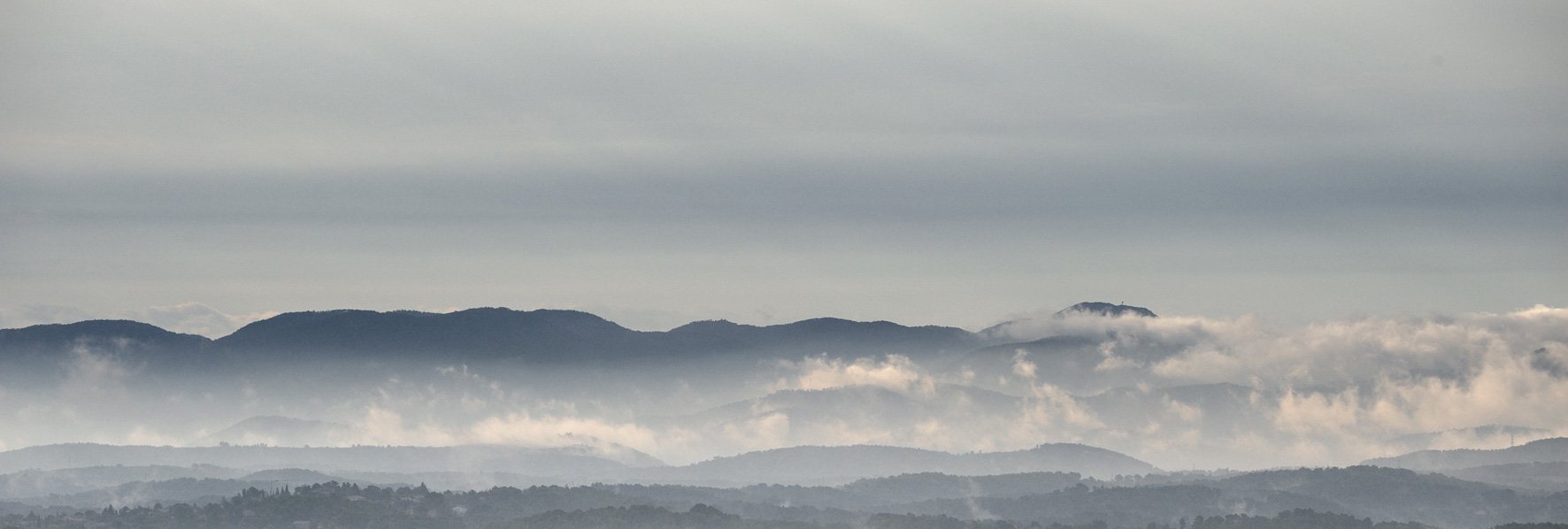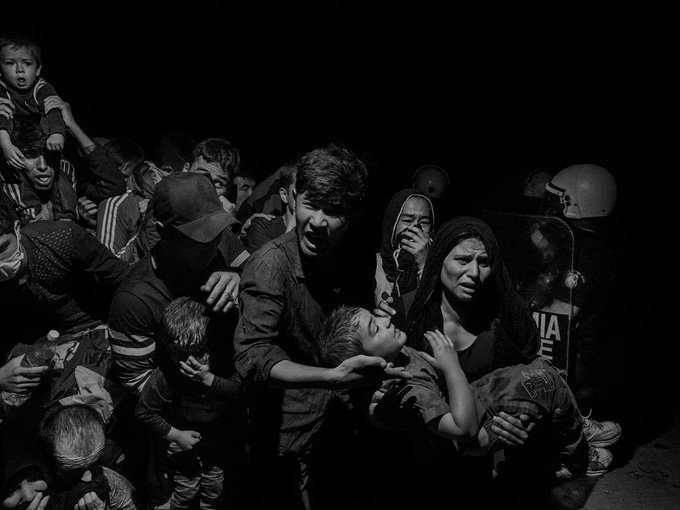The Fondation des Treilles Photography Residency Prize was created in 2011 to help the production of photographic works related to the Mediterranean world.
In January of each year, the jury gathers to award the Photography Residency Prize to support a creation project whose theme is necessarily linked to the Mediterranean world. The prize is awarded to 2 or 3 photographers who share the 8 months of annual residence. The length of the residency can neither be less than 1 month nor greater than the duration of the prize awarded by the jury.
The Photography Prize includes :
- an allowance of € 2,650 per month, the payment duration of which cannot exceed the number of months awarded by the jury.
- a stay which cannot last less than 1 month, especially to ensure the completion of the tests on site.
The laureates are accommodated in one of the Treilles estate houses. Meals and cleaning are provided by the foundation, which allows them to dedicate themselves exclusively to the achievement of their photographic project.
To carry out their photographic works, they have access to :
- a digital workshop with a professional computer and a large-format sprayed pigments printer,
- a film laboratory, the “Jacqueline Hyde Laboratory”, with a multiformat Beseler enlarger, for those who wish to develop and print images in black and white.
The laureates also benefit from a library and a wireless internet connection at the “Grande Maison”.
Artists wishing to compete for the Prize are invited to read the terms and conditions of participation.
For any questions or requests, please send a message to the following address: prix.photo@fondationdestreilles.com.
To know when to apply, please consult the following page: calls for applications.
The application file consists of :
- a form to complete online,
- 10 to 20 images JPG format, 300 dpi, compression average quality, the long side of the image not exceeding 12 cm.
Application forms and digital preselection files must be sent to the email address mentioned above.
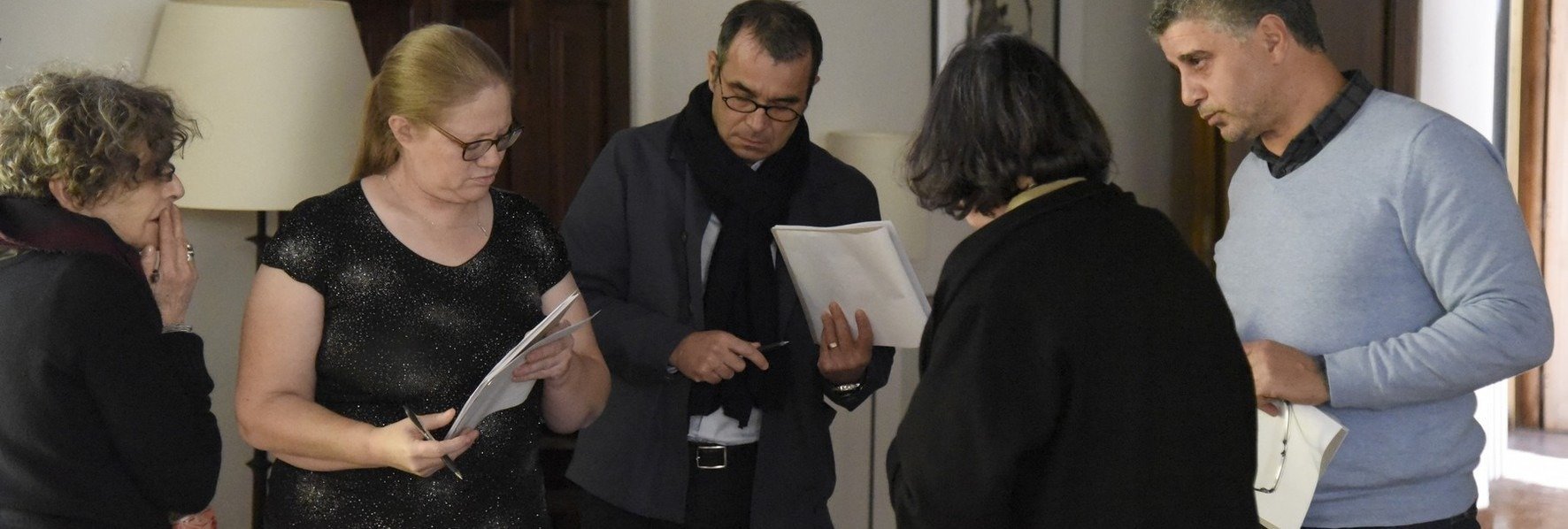
Réunion du jury pour le prix “Résidence pour la Photographie” © Olivier Monoyez
Winners over the years
Dana Cojbuc, Aurelia Frey, Eponine Momenceau
Dana Cojbuc
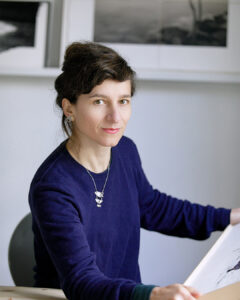 Born in 1979 in Romania, Dana Cojbuc graduated from Fine Arts in Bucharest and now lives in Paris. After developing photographic work for several years, she made a singular and sensitive transition to drawing. During an artistic residency at the Sunnhorland Museum in Norway in 2019, there was a shift from a purely photographic approach to a drawn vision of the landscape. From her own prints Dana Cojbuc extrapolates, redefines the limits and reinvents the subject through drawing. The border between photography and charcoal work is subtle, mysterious, it opens the way to an imaginary landscape. This extension through drawing acts as a revealer of the graphic and plastic character of the real landscape, in which she sometimes intervenes beforehand in the manner of a Land Art artist.
Born in 1979 in Romania, Dana Cojbuc graduated from Fine Arts in Bucharest and now lives in Paris. After developing photographic work for several years, she made a singular and sensitive transition to drawing. During an artistic residency at the Sunnhorland Museum in Norway in 2019, there was a shift from a purely photographic approach to a drawn vision of the landscape. From her own prints Dana Cojbuc extrapolates, redefines the limits and reinvents the subject through drawing. The border between photography and charcoal work is subtle, mysterious, it opens the way to an imaginary landscape. This extension through drawing acts as a revealer of the graphic and plastic character of the real landscape, in which she sometimes intervenes beforehand in the manner of a Land Art artist.
Her works have been exhibited in prestigious international museums and festivals such as the Sunnhorland Museum (Norway), the Backlight Festival in Tampere (Finland), the Circulations Festival (Paris), the Manifesto Festival (Toulouse), at the Maison de la Photographie of Central Europe in Bratislava (Slovakia)… Her works have joined several public and private collections. Finalist of the Brussels festival Photo Prize – In the shadow of trees in 2021, she received the Jury Prize for the Tremplins Jeunes Talents residency at the Planches Contact Festival in 2022. The same year, she was awarded the “Paysage” talent grant and publishes her first book Yggdrasil. She is represented by the Catherine Putman gallery in Paris.
Her project
En Levko
Grèce, Volax (Tinos), 2025
At the crossroads of photography and drawing, her work is inspired by landscapes, mythologies and personal memories, weaving a thread between the sensitive and the imaginary, between reality and fiction. White has always occupied an essential place in my universe, manifesting itself in turn as breath, matter – snow, cloud, foam – and symbol.
The series En levko (which could be translated as Carte blanche or Libre cours), will be a continuation of her poetic and visual research, taking as a starting point the mineral and lunar landscape of the village of Volax, on the Tinos island in Greece. This work will allow her to deepen her explorations around white, considered in its entirety as colour, presence and essence. White, having a deep meaning for this region, then emerged as a natural starting point for this project. It is the incarnation of the vernacular architecture of the Cyclades, with its whitewashed houses, the foam of the waves stirred by the Meltem, the marble of the statuary and the laundry drying on the windows. It is the feather of doves and the trace in the ground of the winding paths between the island villages. It is the color of inspiration as much as of its absence, of the blank page and of silence, but also the radiance of the light which, in its dance, magnifies the Greek panorama.
Aurelia Frey
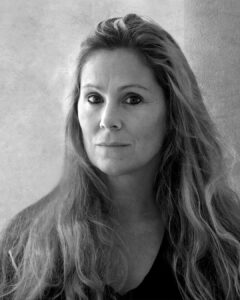
Born in 1977, Aurelia Frey graduated from the École Nationale Supérieure de la Photographie in Arles. She was a member of the artistic section of the Casa de Velazquez in Madrid from 2008 to 2010. She lives and works in La Rochelle within the Essence Carbone collective.
Through her photographic work, Aurélia Frey questions the notion of passage. Interested in literature and painting, she weaves links between the literary and pictorial worlds and photography.
Aurélia Frey has participated in various residencies in Cambodia, Vietnam, Iceland, Finland, Norway and France.
She has exhibited in several festivals (Réseau Lux #1, Itineraries of traveling photographers in Bordeaux, Festival Manifesto in Toulouse, the Biennale Fotonoviembre in Tenerife, Marseilles Festival…) and has participated in exhibitions in France, Norway, Romania, Spain, Egypt, Cambodia.
Her project
«My grandmother had two favorite lands, two countries close to her heart : the one that we do not choose, where we are born, and that she loved with a love that did not weaken: the highlands of the Cévennes ; the one she discovered, which she chose and which provoked a sense of wonder from which we never return: Italy. Two sides of the same world, the Mediterranean, two sides that are very different but which, in my eyes, shed light on who she was.”
I would like to create a portrait of my grandmother linked to this double belonging of birth and election. Work that I will title “On the shoulder of time” in reference to a poem by Kamal Zerdoumi, a poem which summons memories similar to “swarms of butterflies” in an effort by Memory to erase “the wrinkles” of time.
My photographs collected in the Cévennes and Tuscany will therefore be mosaic moments that I will then have to assemble or re-assemble between absence and presence, between reality and imagination, and whose porous borders will allow an incessant coming and going between the lived and fantasized, between the past and the present but also between her and me, between the old lady from the olden days and the little girl from that time, who listened to her. So halfway between the myth and the reality of these two Mediterranean countries with their common points and their strong contrasts, I will pay tribute to the one who knew how to make me dream…»
Eponine Momenceau
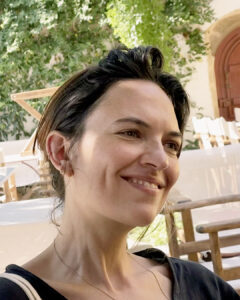 With a musical background (graduated from the Paris Conservatory in harp), Eponine Momenceau quickly confronted the image after discovering “master” paintings linked to historical periods of the musical repertoire. In 2007, after years of self-taught photographic practice, she entered the Image section at Fémis. In the moving image, whether narrative films or closer to her sensitivity, the experimental films of artists, she finds this practice of immersion in a temporal continuum that she has already experienced in the musical universe.
With a musical background (graduated from the Paris Conservatory in harp), Eponine Momenceau quickly confronted the image after discovering “master” paintings linked to historical periods of the musical repertoire. In 2007, after years of self-taught photographic practice, she entered the Image section at Fémis. In the moving image, whether narrative films or closer to her sensitivity, the experimental films of artists, she finds this practice of immersion in a temporal continuum that she has already experienced in the musical universe.
From film projects to exhibitions, she is increasingly captivated and fascinated by these units of suspended time close to the image of photographers. In 2012, she showed her SONG installation at the 57th Montrouge show for which she won the Hauts-de-Seine General Council Prize. Then the exhibitions follow one another (Palais de Tokyo, Nuits Blanches, Milan Triennale, Tank Shanghai, etc.). In the meantime, she met Jacques Audiard and created the image for the film Dheepan, which won a prize at the Cannes Film Festival.
Her project
Work on traces and memory
Her work is oriented towards the attempt to experience time in an image, and no longer the experience of a movement in time, thus detaching itself from the filmic image. A work on the decomposition of time by recording sequences of very short video images, the objective being the formatting of this corpus of images in the form of a series.
Initiated around the Mediterranean for more than 10 years now, the project is undeniably rooted in the Mediterranean world. The one that Albert Camus describes as «an international basin crossed by all currents»; a Mediterranean which connects culture to life, a Mediterranean «diffuse and turbulent (…), which surrounds us with smiles, sun and sea and which teaches us the lesson. » «A space-movement » (Fernand Braudel). «Classically, the Mediterranean sea is considered a crossroads of civilizations. Although today we can consider that reality is much more fragmented and diverse, the source is there, in this Mediterranean area. I hope the images are imbued with this history, this light and this sun, like the threads that weave around a story, both intimate and collective. »
Jean-Christophe Ballot, Paul Lemaire, Mohamed Mahdy
Jean-Christophe Ballot
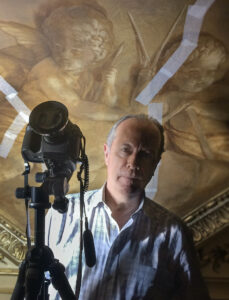
Jean-Christophe Ballot is a contemporary photographer, born in 1960.
For more than thirty years, he has pursued a unique path in the artistic world, claiming and practicing contemplative photography.
In 1987, a graduated architect from the government and student at the National School of Decorative Arts in the photography department, Jean-Christophe Ballot received a two months scholarship from the Franco-German Youth Office in Berlin.
He uses a Sinar studio room to make his first urban landscapes. These photographs were then presented to the jury of the Villa Medici and allowed him to work in Rome in 1991. During all these years the portraits of cities continued through meetings, opportunities and invitations. A highlight of his journey has been the personal exhibition – Urban landscapes – in 2008, at the European House for Photography.
Upon his return from Rome, he began a collaboration with the Louvre Museum, whose construction he followed from 1992 to 2002. He published four works: The Grand Louvre, The Louvre in Metamorphosis, The Louvre Transfigured and The Secret Life of the Louvre and exhibited at the Louvre in the model room in 2003. Statues travel through his images, his books up to his latest work in 2022 – The Epic of Gilgamesh – published by Diane de Selliers.
His favorite themes include natural landscapes, for which he had many orders, including photographic observatories and a residency in 2009 to photograph the Sainte-Victoire mountain. He photographed Cézanne’s mountain for a year and published The Thirty-Six Views of Sainte-Victoire (Gallimard) with texts by Peter Handke.
Another theme with places of memory and metamorphoses : the industrial wastelands of the Renault factories on Seguin Island, the Susse foundry, the Auteuil greenhouses, the monasteries of Mount Athôs… In October 2022 the B.n.F. editions published Richelieu la traversée, a poetic look at the ten years of the construction of the National Library of France, “a thrill of things that escape”. His artworks are part of the collections of many museums.
His project
Rome, a look on four centuries of eternity…
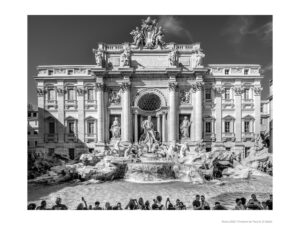 It involves carrying out a research and creation project on four centuries of representations of Rome through urban landscapes. It is designed with the approaches of a photographer, an architect and a collector. Jean-Christophe wishes to return to Rome, thirty-two years after his residence at the Villa Medici, to take a new look at the urban landscapes of this city through the prism of heritage and memorial questions as well as the environmental and ecological issues which were not relevant in 1991. He wants to come back with thirty years of work on urban landscapes around the world and with digital tools. Take a new look and new practices for a new project.
It involves carrying out a research and creation project on four centuries of representations of Rome through urban landscapes. It is designed with the approaches of a photographer, an architect and a collector. Jean-Christophe wishes to return to Rome, thirty-two years after his residence at the Villa Medici, to take a new look at the urban landscapes of this city through the prism of heritage and memorial questions as well as the environmental and ecological issues which were not relevant in 1991. He wants to come back with thirty years of work on urban landscapes around the world and with digital tools. Take a new look and new practices for a new project.
For years he has been collecting urban landscapes of Rome with engravings by Piranesi, other 18th century prints and 19th century photographs. With his work produced in 1991, in the last century, he wishes to put into perspective the representations of the city over four centuries. DPLG architect in 1986, then resident at the Villa Médicis in 1991, he then photographed urban landscapes with a 4’x5’ camera. Today he wants to write a new digital page. His project on the Eternal City is historical, environmental, artistic and poetic.
Paul Lemaire
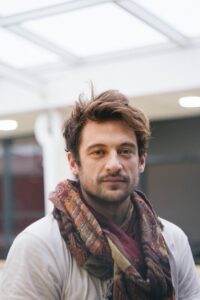
Paul Lemaire is a 32-year-old documentary photographer from the French Alps.
After obtaining an engineering degree, he decided to leave this path to tell the stories of the people he met. It was at EMI-CFD in Paris that he refined his photo skills in 2019-2020 under the eye of Guillaume Herbaut and Julien Daniel. During a trip with his classmates, he founded the Hors Format collective.
Since then, he has gradually moved towards longer subjects, mainly related to his family history or the consequences of Western consumption on the populations and biodiversity where the raw materials are extracted.
Photographer and editor, his work has been published in Le Monde, L’Obs, Médiapart, Le Parisien, Equal Times and Libération.
His project
The mist of fairies, a Provence from the Far East
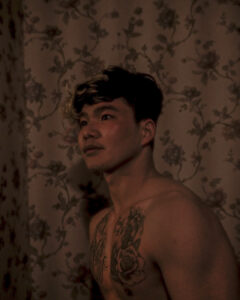
It’s a story that begins in a bowl.
“At the foot of the Sainte-Victoire mountain, my grandmother placed us a broth seasoned with nuoc man, a treat without qualms. Until the day when, playfully, I presented the sauce to friends. The repulsion is instantaneous. Yet without any apparent Asian trait, I become aware of a tiny trace of my family’s identity, in me – Vietnam. My great-grandfather Phin was born in Cochinchina, in the land where legend has it that the inhabitants are the children of a dragon and a fairy. Her daughter, my grandmother, although talkative, does not talk about her. So with the little information I have, I retrace Phin’s journey as if he had experienced it today. This work takes me in particular to the place where he set foot in France for the first time in 1918: Marseille”.
Alain Ruscio, researcher in colonial history, writes: “France and Indochina, like the Provençals and the Indochinese […] still maintain rich and complex relations.“It is no coincidence that Phin chose Marseille to disembark and end his days. It was “a colonial city, better still, a colonial capital, well before Paris and the large ports of the north” he adds. The city and its surroundings then became de facto regions of passage, welcome and exoticism. In the streets of the Marseille city, coffee was transported from South America to Vietnam – which later became the 2nd largest producer in the world – and it is also in Marseille that there are the largest number of Vietnamese restaurants. in France: from this frontage position facing the Far East, societal legacies were forged on the French coast.
In Provence, I therefore go in search of elements to reconstruct a family story but also a period that is still little studied. That of migrations from the Far East during the colonial period between 1870-1950. Because I discover throughout my work that my history, our history, is intimately linked to French history and its questions of identity.
A dialogue then emerges between two stories – that of Phin, embroidered through the near-silence of my grandmother to tell the second, the one which is still timidly written today by a diaspora and a descendant – the legacy of French colonialism in the surroundings of the Phocaean city. I seek to tell these two elusive myths to better accept them, to lift a fog from History.
Mohamed Mahdy
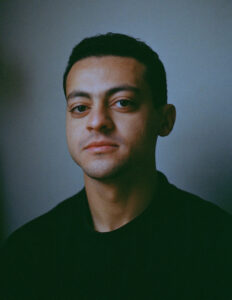
Mohamed Mahdy, born in 1996, is a visual storyteller from Alexandria, Egypt. His work concentrates on the hidden and often unseen communities facing the imminent threat of disappearance in Egypt, tackling diverse cultural and social issues not only to raise awareness but also to foster a vital reconnection between diverse classes with the aim of effecting positive change.
It started with his first Long-term project Moon Dust which led a cement factory built 10 meters away from a residential area to change its unethical behavior, install filters to its chimneys, and provide aid to the affective families, it has taken the attention of New York times to write about it and led to wider collaborations and attention to it’s residents later.
Mahdy graduated from Pharos University PUA Arts and Design media department and was awarded a scholarship, and completed two diplomas at Denmark’s Danish School for Media and Journalism.
In 2018, Mahdy was named by The New York Times Lens Blog as one of 12 emerging photographers to watch. In 2021, he was selected as a Photography and Social Justice Fellow of the Magnum Foundation, and in 2022, he was named by The Guardian as one of five emerging talents in photojournalism.
Mahdy’s work has been exhibited worldwide, notably as part of the Sharjah Art Foundation, Hamburger Bahnhof Museum, The Altonaer Museum, Photoville Festival, Geo polis Belgium, MEI Institute, and Institute du Monde Arabe in France Biennale. He won multiple international awards. Recently he won The World Press Photo 2023 both regional and global awards for his multi-media project Here, The Doors Don’t Know Me.
His project
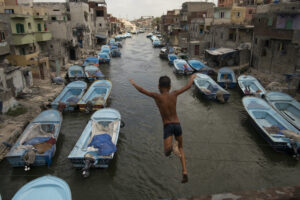
In the neighborhood of El Max, a once-picturesque fishing community in Alexandria, Egypt, residents face the devastating news of their imminent displacement. Labeled “Little Venice” for its canal-side charm, their homes, and livelihoods are threatened by a government demolition plan. Years of uncertainty and a state-led media campaign have fueled resistance, but the demolitions continue. Here, the doors don’t know me inspired by the fishers’ plight, embarks on a project to capture their stories, collaborate with the community, and preserve their memories through photographs and heartfelt letters. As the sea-faring community loses their homes, their shared narratives become a testament to their resilience and unity.
Julie Bourges, Eric Bouvet, Olivia Gay
Julie Bourges
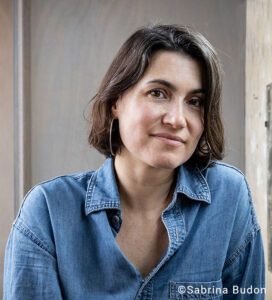
Inspired by artists who blur the boundaries between reality and dream – Fellini, Angelopoulos, Calvino – she seeks a more subtle level of perception. His images are fragments – often minimalist – of doors, in a way, which would open on the journey of the mind, towards an interior or exterior exploration.
For ten years, she composed very introspective series that are like passages or crossings.
Umbra plunges us into the Parisian night.
Haïkus envelops us in the fog of the Venice lagoon in search of an elusive horizon.
Absent bodies probe the mystery of transmission and family and ancestral ties.
Today, she wants to animate her images by adding narration. From Clarissa Pinkola Estes’ book, “Women who run with the wolves”, she began a series of stories about women linked to the professions of the sea. Between mythological story and contemporary characters, these legends of today encourage us to rediscover the path of our soul and our deepest aspirations.
Julie Bourges lives between Rennes and Paris. In 2021, she received support for documentary photography from the CNAP for her entire project on women and the sea. In 2022, she is the winner of the BNF’s major photographic commission for her project on women sailors-fishermen in France.
Her project
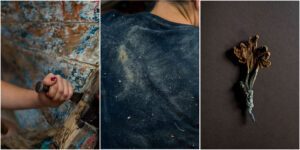
Julie Bourges weaves her story of women and the sea.
After The Hand of the Witch, inspired by the story of Cécile, a young woman shipwright in French Catalonia and Les eaux-fortes, following in the footsteps of the rare women sailors-fishermen, she wishes to open a new chapter by meeting women sailors thanks to the residence at the Treilles Foundation.
In May 2018, she met Cécile, a young maritime carpenter who resuscitated boats eaten away by time. A few hours later, she discovers a coral with branches like fingers swollen with warts which bears the evocative nickname of “the hand of the witch”.
From this coincidence, she created an allegorical story around the questions of this young woman, passionate about her profession, and her fierce desire to exist in a world of men.
The story of Cécile, made in French Catalonia, is the first part of this collection that she was able to continue by creating a new chapter on women sailors-fishermen: Les eaux-fortes (etchings). They have in common a love of nature, work in the open air and a strong character. They experience both the difficulty of being a woman in a very masculine environment and that of doing a job that is tending to disappear.
At sea, women have long been seen as a threat to a ship and its crew. And if female figures were erected as protective goddesses at the prow of boats, women were not to be embarked or crossed before boarding. Although it is ancestral, this legend still weighs today on those who work at sea.
Through these women she meets, it is the sea that Julie seeks. This sea that confronts us with elsewhere, with adventure, with travel. This fascinating and frightening sea. She wants to explore the depth and the imagination of this physical, mythological, ancient and literary space that is the Mediterranean Sea through the portrait of women who sail in the region of Sète and Marseille, two of its emblematic ports.
By working on this sea which saw the birth of the first navigators and Homer, the first poet of our Western culture, who described its currents and winds so well, she will continue to tell the intimate odysseys of these women long confined to protective figures at the prow of boats and who by taking to the sea free themselves from ancestral beliefs by the strength of their bodies.
Its field is not only geographical, it is also interior. It is rooted in the call of the sea from which women have long been kept away, dispossessed. Today, more and more of them are seizing it, a symbol of a profound social transformation.
Eric Bouvet
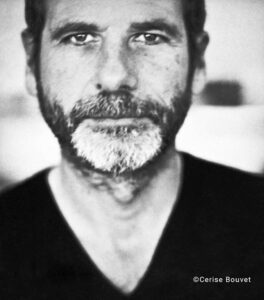 After studying arts and graphic industries at the Estienne school, he joined the Gamma agency in 1981. The famous images of the attempted rescue of little Omeyra, in Colombia, earned him his first international distinction in 1986.
After studying arts and graphic industries at the Estienne school, he joined the Gamma agency in 1981. The famous images of the attempted rescue of little Omeyra, in Colombia, earned him his first international distinction in 1986.
To date, he is the only journalist to have worked with Russian commandos in an active conflict zone.
From this unpublished report, carried out in Chechnya, he will write an astonishing book which will lead to the creation of a play: “To the end”. Independent since 1991, he has covered the biggest world events of the last 40 years, in 140 countries and for the biggest magazines: Life, Stern, Time, Paris-Match, The New York Time’s Magazine, The Sunday Times Magazine, Der Spiegel, Geo or the Figaro Magazine.
After studying arts and graphic industries at the Estienne school, he joined the Gamma agency in 1981. The famous images of the attempted rescue of little Omeyra, in Colombia, earned him his first international distinction in 1986.
To date, he is the only journalist to have worked with Russian commandos in an active conflict zone.
From this unpublished report, carried out in Chechnya, he will write an astonishing book which will lead to the creation of a play: “To the end”. Independent since 1991, he has covered the biggest world events of the last 40 years, in 140 countries and for the biggest magazines: Life, Stern, Time, Paris-Match, The New York Time’s Magazine, The Sunday Times Magazine, Der Spiegel, Geo or the Figaro Magazine.
Since 2011, he has also produced documentary projects in large format, 4×5 or 8×10. After the series “Sex, Love”, “Peace” and “Chaos”, he distinguished himself with “Hexagone: Voyage(s) en France” (Hexagone: travels to France). Supported by the Ministry of Culture, this meticulous and demanding portrait work invites you to discover the full diversity of our compatriots. This extensive work, bringing together more than 500 shots, was the subject of an exhibition in Paris.
In 2019, he joined the American agency VII Agency, for which he carried out major work on the Covid-19 crisis. A work noticed and hailed by his peers: Éric Bouvet was recognized by the magazine Polka, photographer of the year 2020.
In 2014, on Maidan Square in Kyiv, the police fired on a people fighting for their freedom. Eric was there. In February 2022, Ukraine finds itself again plunged into horror. The photoreporter is still there to document the exiles, the bombings, the exhumations of bodies, the disappearances. But this time, he offers a daily account of his journey, in the form of films combining still and animated images. Broadcast every evening on social networks, the “sonoramas” fascinate tens of thousands of Internet users. This community will pre-finance a book (Ukraine 2022) and the “Ukrainian sonoramas”, with their unique approach, will be praised by the profession (Night of the Year, Arles 2022; special mention from the jury of the Golden Visa of Digital Information France Info, Perpignan 2022; Carte blanche at the Élysée museum, Lausanne 2022).
Along the way, Bouvet received five World Press Awards, as well as two Visas d’Or, the Gold Medal for the 15th Anniversary of Photography, the Bayeux-Calvados Award for War Correspondents, the Bayeux Audience Award-Calvados, the Front Line Club Award and the Paris-Match Award.
His project
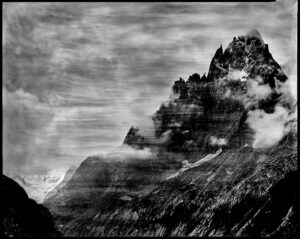
Places of passage for traders, migrants, diplomats, soldiers, tourists and sportsmen: the mountain passes of the Franco-Italian border have shaped history. Important strategic and geopolitical stakes, they mark a border with an eventful layout.
Between the 18th century and today, two states will constantly dispute the two slopes of the passes of the Western Alps: the kingdom of France and the kingdom of Sardinia. If the Dauphiné fell into the hands of the French in 1349, it was during the peace treaties of Utrecht (1713) ending the War of the Spanish Succession that the border would experience a profound change. Goodbye Savoy, hello fortified locks (Briançon and Mont-Dauphin).
While Bonaparte had his portrait taken as he passed the Grand-Saint-Bernard (Switzerland), first on the back of a mule then perched on a prancing horse, the left wing of his army reached Italy by the roads of Mont Cenis pass. Six main passes then allow a passage of the guns. In addition to Mont-Cenis, there are the Col du Petit-Saint-Bernard, the Col du Montgenèvre, the Col Agnel and the Col de l’Argentière.
The Col de l’Échelle was then only an entirely French pass. The Treaty of Utrecht, with the criterion of hanging waters, will make it a border pass that Captain Brossier will judge as fundamental because of its low altitude (1762 meters). Or the lowest pass of the Franco-Italian border, and even of all the Alps. It is also today the preferred crossing point for illegal migrants.
After the wars, the passes became collaborative places between the two nations, both from an economic and commercial point of view. Without counting on the passage of cattle which has completed the shaping of certain passes such as that of Larche, a mecca for transhumance. Animals from all over Provence and the surrounding area would take up their summer quarters on the Piedmont side of this pass. The passes were therefore used in the 18th century not only by merchants coming to fairs, but also by herds to graze on the other side of the ridge line.
Today, every year, these passes are crossed by the cycling tour of Italy and the tour of France with its cohort of publicity caravans and motorhomes of supporters. It will take two months to cover these dozens of passes with a story, on the border of these two Mediterranean countries.
Olivia Gay
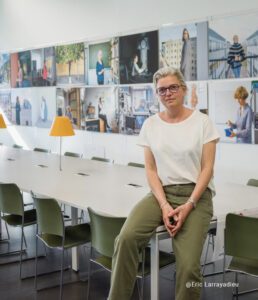 Born in 1973, Olivia Gay studied art history and then photography. She first worked as a press photographer before moving towards visual photography. Her approach combines documentary approach and aesthetic research and is built over time and closeness with people, mainly women.
Born in 1973, Olivia Gay studied art history and then photography. She first worked as a press photographer before moving towards visual photography. Her approach combines documentary approach and aesthetic research and is built over time and closeness with people, mainly women.
This research has continued since today in the form of a research and creation doctorate within the framework of the RADIAN program: “Women at work. For a comprehensive photography” (in reference to the sociological concept forged by Max Weber questioning the representations and the meaning that the actors give to their activity).
Her project
Her project, provisionally entitled “Research”, will be carried out on the Treilles Foundation estate, in the heart of a 300-hectare landscape “conducive to creativity, reflection and exchanges”. From a research on the mediterranean light and the links between painting and photography, she will endeavor to make visible the presence of the invited people (scientists, artists, external speakers) in order to question this what does it really mean to “seek” or how to make visible, through the photographic gaze, the world of ideas.
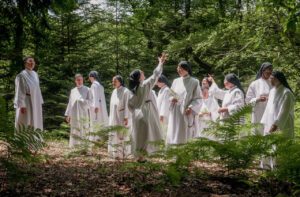
Mohamed Camara, Karine Pierre, Alain Fleischer
Mohamed Camara
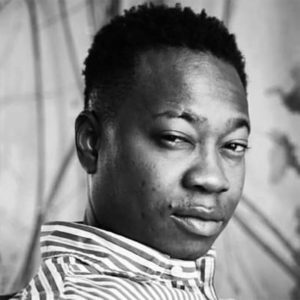
Born in Bamako in 1985, Mohamed Camara began photography in 2001, self-taught, with a digital camera that had been loaned to him. His first series, “Malian Rooms”, was exhibited at the Pierre Brullé Gallery as part of the Photography Month in Paris in 2002, then at the Bamako Photographic Meetings the following year. The Tate Modern devoted him a personal exhibition in London in 2004, for which he made his first video, “Les rideaux de Mohammed” (Mohamed’s curtains). His subsequent series, including “Certains matins et Souvenirs”(some mornings and memories), have been presented at numerous exhibitions, notably in France, Germany, Spain, the Netherlands, Switzerland, the United States and Canada. His works are part of the collections of the National Museum of Modern Art, the Georges Pompidou Centre, in Paris, and in those of the European House of Photography, which commissioned a series from him in 2007-2008 on “Malians in Paris”. Mohamed Camara lives and works in Bamako.
His project
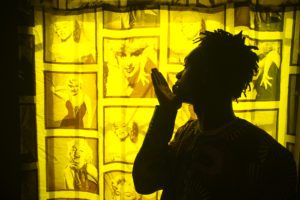
“My photographs can be read like boxes in comic strips. As a young man, I began to dream of the world and to photograph it through the curtains of the rooms where we spent our days in Bamako. My career gave me the chance to cross the Mediterranean in both directions. During the Treilles residency, in the nearby countryside and in the surrounding villages, I propose to install elements designed in Bamako as points of passage between different worlds: bubbles filled with water in which I insert, physically, images of beings that I miss. I would like them to”discuss” with the fountains and springs of the place; curtains, embroidered in Bamako in preparation for the project and of which each copy will be bearer of a story. Once installed in the domain using crossbars, their play with the wind will reveal sub-stories, actions staged in the chosen landscapes and framed beyond the curtains, nourished by the daily of a Sahelian in residence: the adventures of Mohamed Camara in Tourtour!”.
Karine Pierre
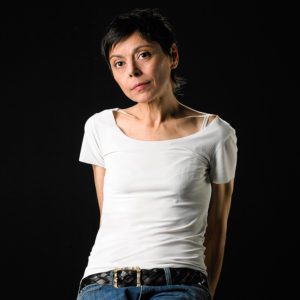
A graduate of the National Conservatory of Geneva, Karine Pierre worked in theater from 1990 to 2018. In addition to her career as a theater actress, editor and film director, she began self-taught photography in November 2015. In the process, she worked with a press agency in London before joining Hans Lucas at the end of 2017.
In the summer of 2018, she decided to devote herself exclusively to photography and began training at the Gobelins image school while continuing to cover social and political news in France. At the end of 2019, she started focusing on longer-term documentary subjects and traveled to Libya where she worked on the front line in Tripoli and on the consequences of war in an urban setting. In 2020, she traveled to Lebanon a few days after the explosion in the port of Beirut. There, she worked on the consequences of the economic crisis on the populations residing in Beirut, in Akkar and in the Bekaa. This photographic work entitled “Aftermath” is showed at the 2021 ” Visa pour l’Image Festival”.
Her project: The shredded lands
Sabra – Beyrouth
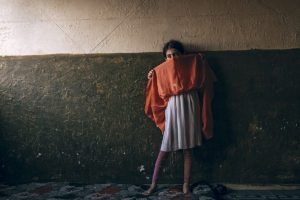
Built in 1978 by the PLO, Gaza Hospital opened its doors the following year in Sabra – West Beirut. Administered by the Palestinian Red Crescent, the hospital then offered state-of-the-art care delivered free of charge to the entire population of the capital.
From 1985 to 1987, during the ‘War of the Camps’, Gaza Hospital was targeted by the Shiite Amal party militias supported by the Syrian occupier. In 1988, the hospital was completely dismantled and the facilities looted or destroyed. From surgical blocks, through the electrical system and to the elevators, nothing will be spared. From the hospital, only an empty carcass will remain to which Palestinians will flock to find a fragile refuge. Gradually, the hospital will house generations of Palestinian refugees and then Syrians escaping the conflicts, but also poor Lebanese workers as well as Egyptian, Moroccan and Bangladeshi migrants fleeing poverty. Gaza Hospital has thus become a condensation of the history of migratory movements in the eastern basin of the Mediterranean Sea. A palimpsest to read in its verticality.
The old hospital located on the outskirts of a city, which was still proud until recently, was erected in an overpopulated area with a large Sunni majority. Its ideological structure, which was the struggle of a people under the banner of the PLO, has changed over the decades to become a concentrate of regional and international pluralities, with no other primary motive than that of survival. The very people who make up part of the population of Lebanon and who divide it, all have become refugees in this urban shred.
Former enemies for some, they now share the framework of the same dilapidated architecture with porous strata, combined by the necessities of extreme precariousness and promiscuity. There, transnational, sometimes transcultural, families are formed by capillarity. In this sense, Gaza Hospital offers the iconography of a “surviving” together, of a society which, if it sometimes remains economically staged, is gradually changing beyond origins and confessions. Here, the demarcation lines that continue to divide the different communities of the country in order to maintain a system of clientelism and corruption, are erased a little, reminding implicitly but not without irony that formerly, this hospital was for all. While the populations of Gaza Hospital operate a slow movement towards a possible hospitality, the terrible economic crisis organized by the bankruptcy of a deadly and discriminatory political system bequeaths to the poorest ones only one thing ‘in common’: to die there together, slowly.
Alain Fleischer
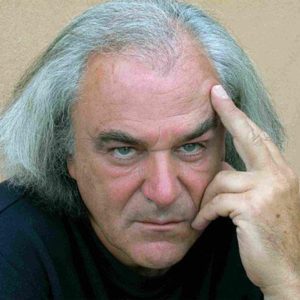 Born in Paris in 1944. Writer, filmmaker, artist and photographer, Alain Fleischer lives and works between Paris, Rome and Tourcoing. He studied modern literature, linguistics, semiology and anthropology at the Sorbonne University and the Ecole des Hautes Etudes en Sciences Sociales (High Studies in Social Sciences School). He has taught in various universities, art, film and photography schools, and has led numerous master classes in France and abroad. Winner of the French Academy in Rome (stay at the Villa Medici 1985/87), he was also named Doctor Honoris Causa of the University of Quebec in Montreal and Doctor Honoris Causa of the European University of Human Sciences of Vilnius, Lithuania. He received the Bernheim Prize for Literature in 2016.
Born in Paris in 1944. Writer, filmmaker, artist and photographer, Alain Fleischer lives and works between Paris, Rome and Tourcoing. He studied modern literature, linguistics, semiology and anthropology at the Sorbonne University and the Ecole des Hautes Etudes en Sciences Sociales (High Studies in Social Sciences School). He has taught in various universities, art, film and photography schools, and has led numerous master classes in France and abroad. Winner of the French Academy in Rome (stay at the Villa Medici 1985/87), he was also named Doctor Honoris Causa of the University of Quebec in Montreal and Doctor Honoris Causa of the European University of Human Sciences of Vilnius, Lithuania. He received the Bernheim Prize for Literature in 2016.
On a mission from the Ministry of Culture, he created the Contemporary Art Fresnoy-National Studio, of which he is now the director. Author of around fifty works of literature (novels, collections of short stories, essays), he was awarded the Georges Dumézil Prize of the French Academy.
His work as an artist and photographer is regularly shown in personal and collective exhibitions in France and abroad, and was the subject of a retrospective in 2003 at the Maison Européenne de la Photographie and in the Pompidou Centre, with the publication of the catalog “La vitesse d’évasion” (The speed of escape), Editions Léo Scheer. Retrospective exhibitions have been devoted to him in the Netherlands, Spain, Brazil, Cuba, Canada, Argentina, Russia, Ukraine, China… He represented France in the Sydney Biennials (Australia), Kuan-Ju (Korea), Havana (Cuba), Busan (Korea).
Director of some three hundred and fifty films, in genres as diverse as fiction feature-films, experimental cinema or art documentaries, his films have been presented at numerous international festivals such as Cannes, Berlin, Rotterdam, New York, Montreal, Venice or Locarno. He has won several awards at the Montreal International Film Festival on Art, which dedicated a tribute to him in 2002. Retrospectives of his films have been presented at the Center Pompidou, the National Galleries of the Jeu de Paume, the new Cinema Pesaro Festival, and at Anthology Films Archives, New York.
His project: Photographic interpretation of Ovid’s “Metamorphoses”.
Through processes and techniques specific to photography, with his ability to transform reality through the manipulation of light and its imprint, thanks to shots both in natural settings and in the studio, the objective is to produce a series of images inspired by the long Latin poem. The photographs will be made using a mixture of techniques, with the presence of characters. The results will be large-format color prints, forming an aesthetically and thematically homogeneous series.
Bernard Descamps, Sophie Hatier, Yusuf Sevinçli
Bernard Descamps
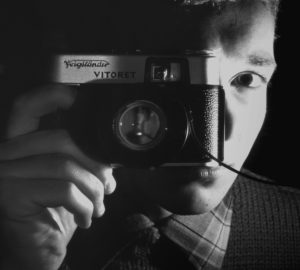
Bernard Descamps was born in 1947 in Paris. He became a photographer in 1975. The legendary Swiss magazine «Camera» published his photographs for the first time in 1974. His first major exhibition was organized by Jean-Claude Lemagny at the National Library of Paris in 1975. The same year, he exhibited with Florence Henri at the «m» gallery in Bochum (Germany). In 1978, he had a personal exhibition at the Pompidou Center in Paris.
He is one of the founding members of the VU agency. He is also the co-founder of the first «African photography meetings» in Bamako. From 2002, the Camera Obscura gallery has been representing and exhibiting him regularly. In 2014, he participated in the group exhibitions: «Faces» at the Vieille charité in Marseille, and «Le mur», with Antoine de Galbert’s collection, at the Maison rouge, Paris. From 1994 to 2012, he was artistic director of «La Passerelle» theater gallery in Gap. In 2019, his 11th book, «Natura», was published by Filigranes. Today he is represented by the Camera Obscura gallery in Paris and the Box gallery in Brussels.
His project
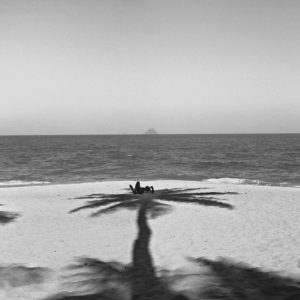
« I would like to follow an itinerary, that of the coast, where the sea meets the land, whether this line is natural or highly urbanized … This approach has often been mine: in Madagascar in 2013, in Vietnam in the 2000s , in Japan in 1993 in the north of France, on the coasts of Brittany … During this trip, the pictures will be encounters, encounters with a place, people, an event, but above all encounters with oneself. In his autobiography «Chronicles», Bob Dylan explains that a song sounds like a dream that we are trying to achieve … I think it’s a bit the same for a photograph. Follow the coastline and take pictures, cut in space and time. I have always hoped that behind the visible aspect of things a spirit was hidden. A kind of animism where photography could reveal a little of what is beyond … Would it be enough to stop time to see beyond appearances? Catch a little of this invisible that Pascal Quignard refers to in the following words : “The visible is not enough to understand what is seen. The visible can only be interpreted with reference to the invisible”».
Sophie Hatier
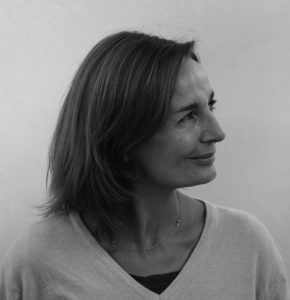
After photographing conflict zones (Bosnia Herzegovina, Middle East …) and working in many countries (Mongolia, Namibia, Senegal, Armenia, Kamtchatka …), Sophie Hatier has moved away from reporting and focused for ten years on a more plastic and sensory approach of the landscape (France, Iceland …), of the portrait and of the living in general. Sophie’s work is focused on nature and its diversity. An approach with no a priori where she focuses on looking with the same attention at a person, an animal, a plant … without a value scale. «Photographing a person like a mountain and vice versa». Colour lover, erasing any anecdote, her images probe the «almost abstract», the tipping point between photography and painting. Her works are regularly exhibited in galleries in France and abroad. She has been a member of the «France(s) Territoire Liquide» association since 2011.
She also collaborates with many magazines: Vogue, le Monde, M du Monde, Le Figaro magazine, Le Point, Libération, Première, Air France Madame, Marie Claire Maison, de l’Air…
She published the following books (in French): In 2004, «Portraits of the Equestrian Academy of the Horses of Versailles» by Éditions Belin, in 2014, « France (s) Liquid Territory, new photographic mission on French territory » by Editions du Seuil, In December 2020, « Grignan, in the time of lockdown», with Editions Temporis.
Her project
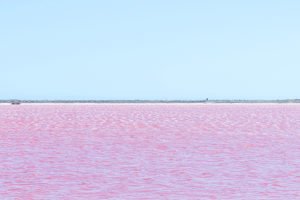
«After rugged and volcanic Iceland, and its magnificent, dull, mysterious northern lights, I was looking for an inverse territory, where all would be horizon, southern light and colours that would radiate and saturate space. A Mediterranean atmosphere. Little by little, the Camargue region, which I knew well without having ever photographed it, became obvious. It was by water that I approached it. Camargue is the reverse of an island. A body of water in the middle of the land. Ponds, swamps, salt marshes, fresh water, brackish water… A landscape which seems so wild but which also results from long-standing human interventions on a very particular biotope, an attempt at domestication by clever transfers of fluids… A Mediterranean space, with its colours, its composition and its material. And on which the light acts as a revealer. I want to capture this specificity of the Camargue territory, I want to capture it by broadening my work to other forms of life: plants, fauna and portraits … This search for a form, starting from nature to tend towards the human, has always been at the heart of my work».
« I stay in the open air because of the mineral, the vegetable, the animal that are in me » (Henri David Thoreau).
Yusuf Sevinçli
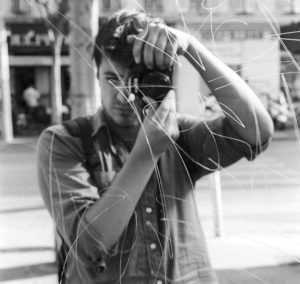
Yusuf Sevinçli is a Turkish photographer born in 1980, who lives and works in Istanbul. He graduated from the Communication section of Marmara University in 2003, and the following year he joined a master class devoted to documentary photography in Sweden. He participated in the «Reflexions Masterclass» with Giorgia Fiorio and Gabriel Bauret in Venice in 2011.
In 2012, he published his first book «Good dog» with Filigranes editions and since then he has published seven other works with different editors, including the recent one «Tourmaline» (self-published, 2020).
His personal exhibitions include «Post» and «Oculus» presented at the Galerie Filles du Calvaire in Paris, the Botanique in Brussels, the Galerist, Istanbul, the Château d’Eau in Toulouse, and the Filatron, in Mulhouse. His work has also been presented in numerous festivals and exhibitions in Europe and around the world.
Yusuf Sevinçli’s work is represented by Galerie Les Filles Du Calvaire, in Paris and by Galerist, in Istanbul.
His project : Cease Fire
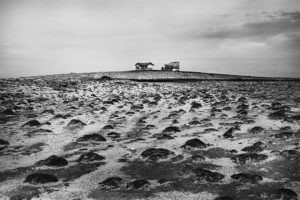
«Cease Fire-Cyprus» will explore the imprint of recent history and conflict on the landscape of Cyprus Island. The third largest island in the Mediterranean, Cyprus stands at a cultural, linguistic and historic crossroads between Europe and Asia. There is a very long standing dispute between Greek-Cypriots and Turkish-Cypriots. The modern history of Cyprus exemplifies the clash between politics and nationalism. This clash has turned a multi-ethnic, multi-religious and multi-cultural island into a scenery of dispute, separation and mistrust.
«During my prolonged stays in Cyprus, my attempt is to trace spatial arrangements of partition and conflict and at the same time traces of unification, peace and integration. I will also try to decode silence and absence in a landscape where nothing apparently happens as a door to past realities still running in the present. The project will challenge me to confront, perform and understand, through photography, the disrupting effects of politics onto geography and people. I am particularly interested in registering the latent yet extreme militarization of the landscape in such a small island and as a subject matter with infinite political and historical nuances, Cyprus has been neglected so far in the area of photography. And yet, taking into account the ongoing polarization and growing tension in eastern Mediterranean basin, it provides highly relevant topics for today».
Sylvie Hugues, M’Hammed Kilito, Jean-François Spricigo
Sylvie Hugues
Sylvie Hugues is a journalist, photographer and artistic director of the «Festival du Regard ». She offers portfolio readings at the «Maison Européenne de la Photographie » in Paris, leads a Masterclass with photographer Flore and gives workshops, notably at the «Rencontres d’Arles » (Photographic exhibitions in Arles). She also writes a regular column in the magazine Le Monde de la Photo and collaborates with the « Camera Obscura gallery» during the «Paris Photo fair». In 1992, she participated in the creation of the magazine Réponses Photo (Photo answers), of which she was the editor-in-chief from 1996 to 2014. She published two books of photographs: « Sur la plage » (on the beach) by Filigranes (2006) and «Fra-For » (2011) by Verlhac.
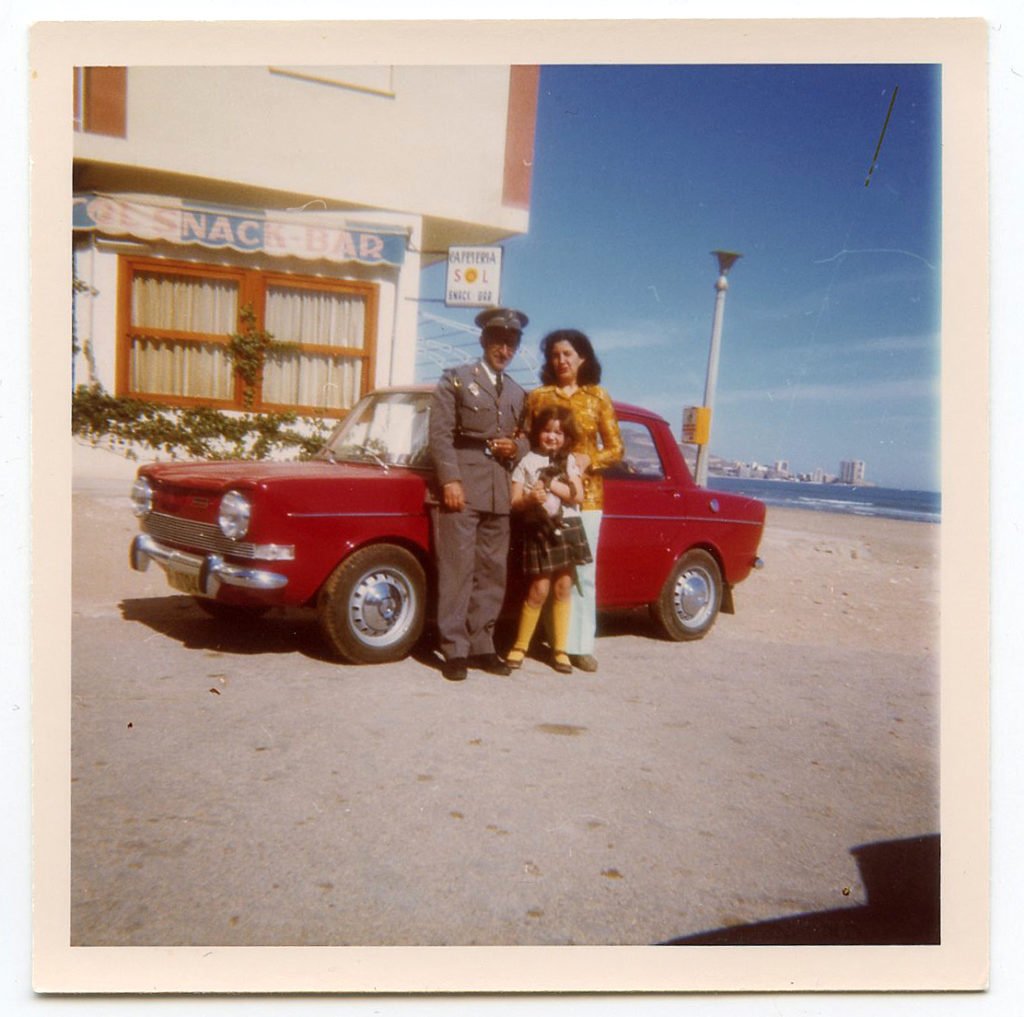
Her project : « El Pueblo »
At 12, Sylvie Hugues’ life changed. She then lives in Cullera, a village near Valencia, in Spain. Returning from a school trip, she is told that her mother has just been murdered by her second husband, a Guardia Civil police officer. She must then suddenly leave Spain, and the paradise of childhood, to find in the Parisian suburbs a father who does not know how to love her as well as an aggressive stepmother. To the grief of mourning is added that of exile. From this period of her life, she has only kept a family album, some yellowed papers and the court judgment. Her father-in-law was only given a two years prison sentence. «Passionate crime » was the reason given then … Today we would rather talk about woman’s murder. Her project « El Pueblo » aims at building a book of texts and photographs to exorcise the demons of the past.
At the age of 18, she cut ties with her family and embarked on film, photography and writing. The memory of her mother and this drama continues to haunt her, but it was in 2014, with new violence, social this time, that this plague reopened. A brutal and unjust dismissal takes her back to her past. She then decides to return to Spain, to find traces of her childhood, to see her class friends again, to greet the nuns who took her in when her mother died. She also plans to see the murderer’s son, whom she considered as her older brother. On the spot she takes notes and photos and decides to build an autobiographical story where her own words and her own images will mix with her family photos and the rare administrative documents found.
Thus was born the « El Pueblo » project which will be finalized thanks to the Treilles residence. It will be building a book of texts and photographs, a work to exorcise the demons of the past, and to propose an « autonomous » work where the intimate becomes universal.
M’Hammed Kilito
The work of the photographer M’hammed Kilito focuses on questions relating to identity, memory, migration and social determinism. M’hammed has been the recipient of a grant from the Magnum Foundation (2018) and participated in the Eddie Adams Workshop (2019). He also obtained a grant from AFAC (Arab Fund for Arts and Culture) and funding from the Prince Claus Fund (2018). His work has been presented at Sharjah Art Foundation (Sharjah), Tate Modern (London), PHotoESPAÑA (Madrid), Amman Image Festival (Amman), Addis Foto Fest (Addis Ababa), Biennale internationale de Casablanca (Casablanca), Rétine Argentique ( Marseille), Fotofilmic Gallery (Vancouver), Beirut Image Festival (Beirut). M’hammed’s photographs have been published, among others, in The Wall Street Journal, World Press Photo, El Pais and the Washington Post. He is a member of the African Photojournalism Database – a project of the World Press Photo Foundation and Everyday Africa. He also contributes to Everyday Middle East and North Africa, a collection of images that give a more precise view of daily life than what is generally seen in the media of the region. He studied photography at the Ottawa School of Art and holds a master’s degree in political science from the University of Ottawa.
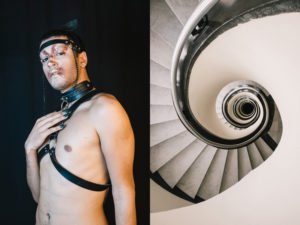
His project : « The Moroccan Youth »
This project is an investigation into the choice of a personal identity for Moroccan youth from a selection of portraits of young people who take their destinies in hand with the courage to choose their own realities, often pushing far the limits of society. Whether through their creative activities, their appearance or their sexuality, they convey the image of a young, awakening, changing Morocco, claiming the right to be different and celebrating diversity. On a daily basis, these young people challenge the conservative and traditional standards of Moroccan society. They cultivate their private oasis despite the obstacles they hit in a country which they say is not progressing at the same pace as they are.
Jean-François Spricigo
Human being with an enthusiastic tendency, quick to wonder and quite impatient, Jean-François Spricigo is not convinced by the need to define himself through a profession, nor by possible medals and other scars, or by anything else. Each day he discovers the intensity of tranquility, welcoming in a better way the necessary storms – sometimes disturbing but always bright – which arise from the mysteries of the night, from the mystery of Life. He thanks from the bottom of his heart the generous outstretched hands of his fellows, cited as each implicitly invited the others: Jacques Brel, Henry David Thoreau, Nine Inch Nails, Friedrich Nietzsche, Osamu Tezuka, Pierre Desproges, David Lynch, Itsuo Tsuda , Alfred Schnittke, Eric Baret, Franz Schubert, Jiddu Krishnamurti, Hiko, and for the occasion the Treilles Foundation to offer him the wings towards this new horizon. He unconditionally loves nature and animals; step by step, he finally lives serenely the inconsistency of the species to which he belongs.
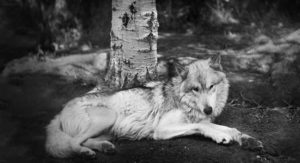
His project : « The wolf »
Nature and animals occupy a place as essential to him as the Human, to tell the truth it even happens that the former participated in reconciling him with the latter. Reconciliation through non-separation is the founding argument of this candidacy. The relationship between the natural and the cultural has been from the start of his work the main vector of discernment to evolve serenely in our complex society. For him, the wolf crystallizes a certain duality in the Man, between his wild part (the wolf) and his domestic part (the dog). To extend the metaphor, the “follower” temperament is called sheep. What a disturbing semantic game to realize that the wolf represents the threat of this blindness, while the dog protects – and therefore prevents – the herd from meeting the lucidity of freedom. Two sides of the same coin. A vision that aspires to discernment is necessarily paradoxal. Starting from reality and legends linked to the figure of the wolf, he would like to deepen the relationship with them, what they symbolize and what they embody, thus humbly bring a more soothing representation on the necessary cohabitation between Man and the animal, through photography and text.
Clément Chapillon, Stéphane Couturier, Safaa Mazirh, Corinne Mercadier
Clément Chapillon
Clément Chapillon is a French documentary photographer who explores the links between people and their land. In 2016, he undertook his first long-term project, in Israel and Palestine, where he adopted a sensitive approach which mixed images and texts extracted from interviews carried out on the spot. His work has gained wide recognition and is the subject of a book, Promise Me a Land, edited by Kehrer Verlag. More recently, he was selected by the British Journal of Photography (Nov. 2018) to carry out a commission on “Wilderness” in California.
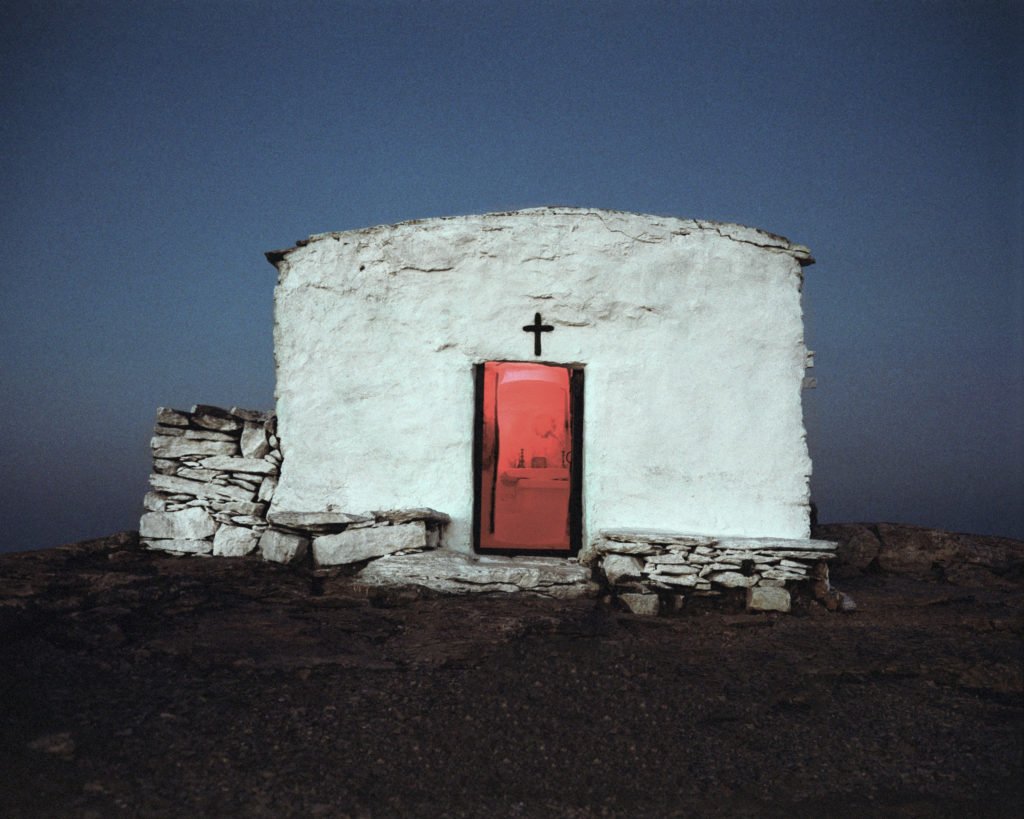
His projet : «Somewhere lies an immortal rock»
«Myths do not have a life by themselves, they expect us to incarnate them» (Albert Camus).
“I discovered about fifteen years ago an island in the heart of the Aegean Sea, Amorgos. It was a shock, «the absolute island», which has become over the years a necessity and an obsession. I went back again and again to find its luminous aridity, its unreal cliffs, its demiurge men, its Homeric swell, its archaic legends and its petrified time … I felt there a Mediterranean of the origins, the incarnation of the Greek myth. But wasn’t it an illusion? What is the share of reality and that of fiction in this fantasy island? Nikos Gatsos, a surrealist poet wrote in 1943 his unique and dazzling work “Amorgos”, on the only mention of the name, without ever being there, strongly convinced that “somewhere lies an immortal rock”. I would like to explore this double dimension of geographical and mental space to compose a photographic testimony that oscillates constantly between poetry and the vernacular, between the icons of yesterday and today’s life in Greece. A documentary story that collects real fragments of a territory to better explore one’s imagination”.
Stéphane Couturier
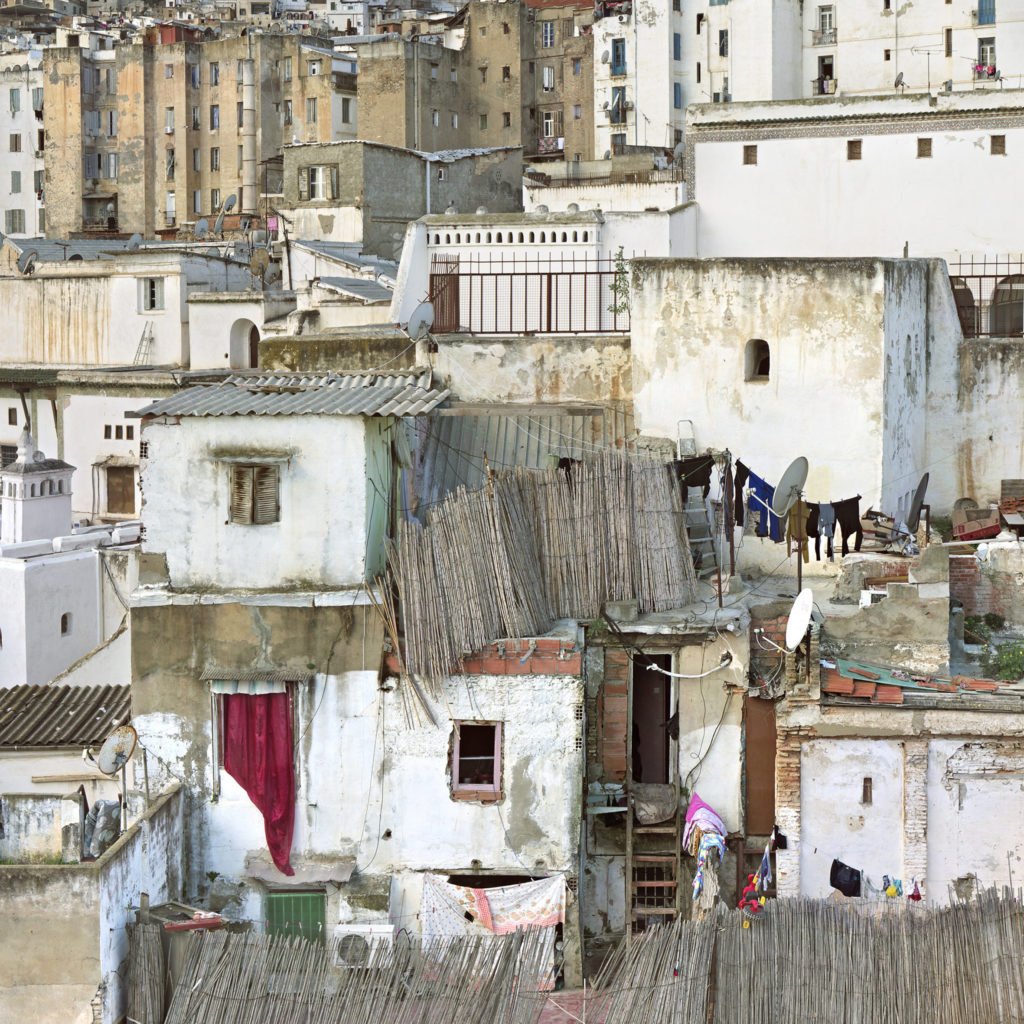
The city, the industry, the built landscapes are the favorite subjects of Stéphane Couturier. This double aspect – the documentary investigation cannot be dissociated from visual research – characterizes his photographic work. His work reveals the different layers of temporality that structure urban centers. The city is comparable to a living organism in perpetual mutation. Since 2004, with the advent of digital, he has decided to experiment hybrid images with the Melting Point series. These works plunge us into an in-between, amid document and fiction, between the concrete reality of things and the virtual reality of their movement, their future. Since 2011, he has been studying Algiers and the housing estates built by Fernand Pouillon. With this series, he encourages us to look at the gaps and asperities of 21st century urban explosions and its populations. In 2018, his series on the city of Sète and the echoes made on Fernand Léger’s work is characterized by a fragmentation of the image. Dynamic tensions and colorful hybridizations, lead to a work of deconstruction of photography. Photography no longer asserts, it invents.
His project: “The walls of Algiers”
The study of the architectural forms of the Kasbah is the starting point of this work on Algiers. These forms are a vector that links the pre-colonial, colonial and post-colonial periods of Algiers. The walls of Algiers intends to document this complexity of the urban development torn between authenticity, imitation and camouflage. Two axes were studied:
– a first axis consisting of urban thresholds where colonial architecture and Kasbah join.
– a second axis attempted, with the notion of informal urban, to seize the making of the “new Algiers” between the legal and the legitimate by studying the temporal sedimentations of the Kasbah.
Safaa Mazirh
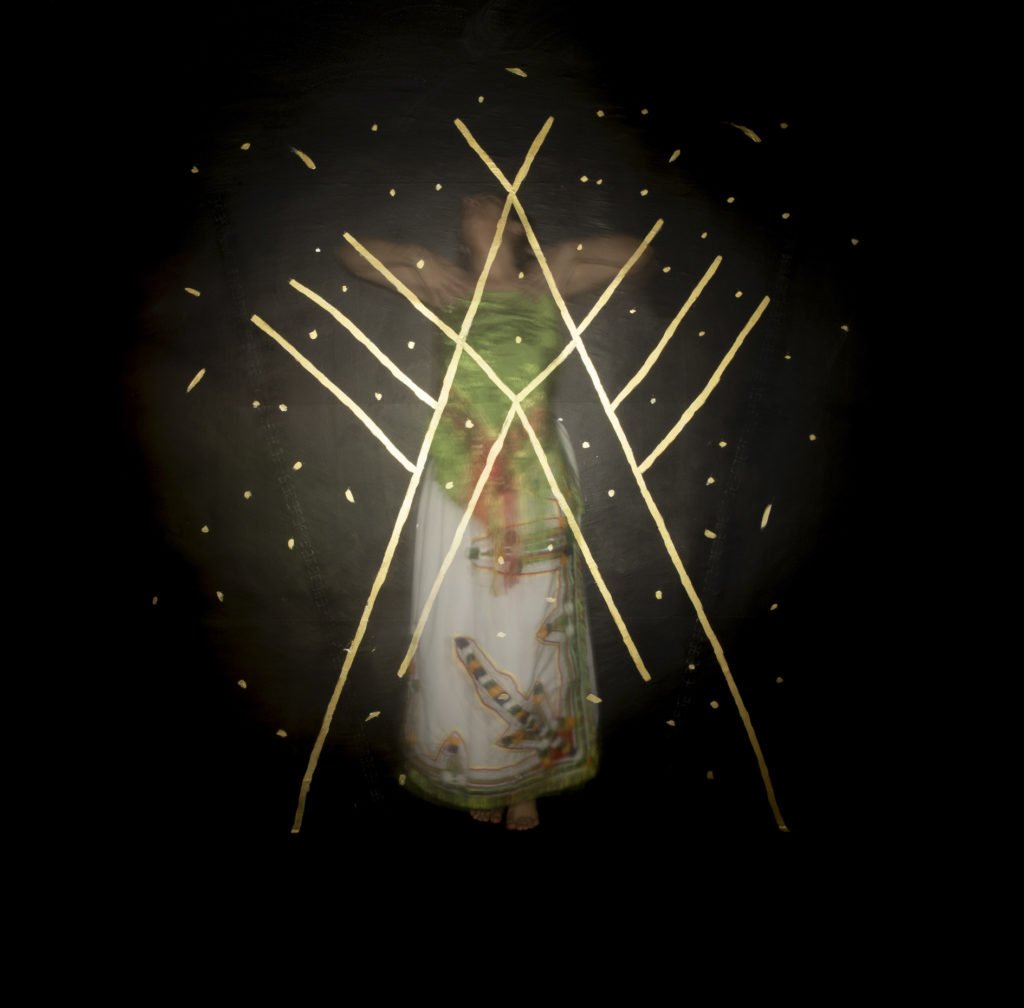
Born in Rabat, Safaa Mazirh lives and works in Casablanca. Artist, self-taught, she discovers photography in the workshops of the association “fotografi’art” which brings together in Rabat several young photographers. Fascinated by the body’s movements on stage, she quickly began to work on this theme for several theater companies.
Her project: « Amazigh revisited »
Tattooing has always been a custom among Amazigh women and it expresses the philosophy of the transition from nature to culture, from oral to written, or of difference … Thus, tattooing is an expression of the identity, the entity, the civilization, the historical continuity of the existence of the Amazigh on the lands of Tamazigh. In Amazigh culture, tattoos have acquired several functions: aesthetic, magic, therapeutic, sexual, anthropological, physical, social, psychological, existential …. Thus the Amazigh man has become more attached to the tattoo philosophy, which expresses its identity, its cultural and civilizational specificities.
« The series “Amazigh Revisited” was initially born from a personal need, that of my identity and my Amazigh culture. I have always been fascinated by the forms and beauty of Amazigh symbols and I was curious to know their senses. I want to recreate this magical and esoteric language and give new life to this feminine writing. The Amazigh series compiles both the symbols and the body that naturally fits in this research process ».
Corinne Mercadier
Corinne Mercadier lives and works in Paris, where she is represented by the gallery “Les filles du Calvaire”. She creates photographic stagings and is as interested in dance, in architecture and big spaces.
To carry out her productions, she calls on models, dancers, actors, who will be her interpreters. She manufactures the costumes and the sculptures intended to be launched during the shots. She also has a practice of drawing, which takes a foothold in the visible world to escape in imaginary scenes. Corinne Mercadier has to her credit numerous exhibitions in France and abroad. For Filigranes, she has published Où commence le ciel ? (Where Does the Sky Begin ?), Dreaming Journal, La Suite d’Arles, a monograph, and Devant un champ obscur (In front of an obscure field). She is represented by the Binôme Gallery in Paris.
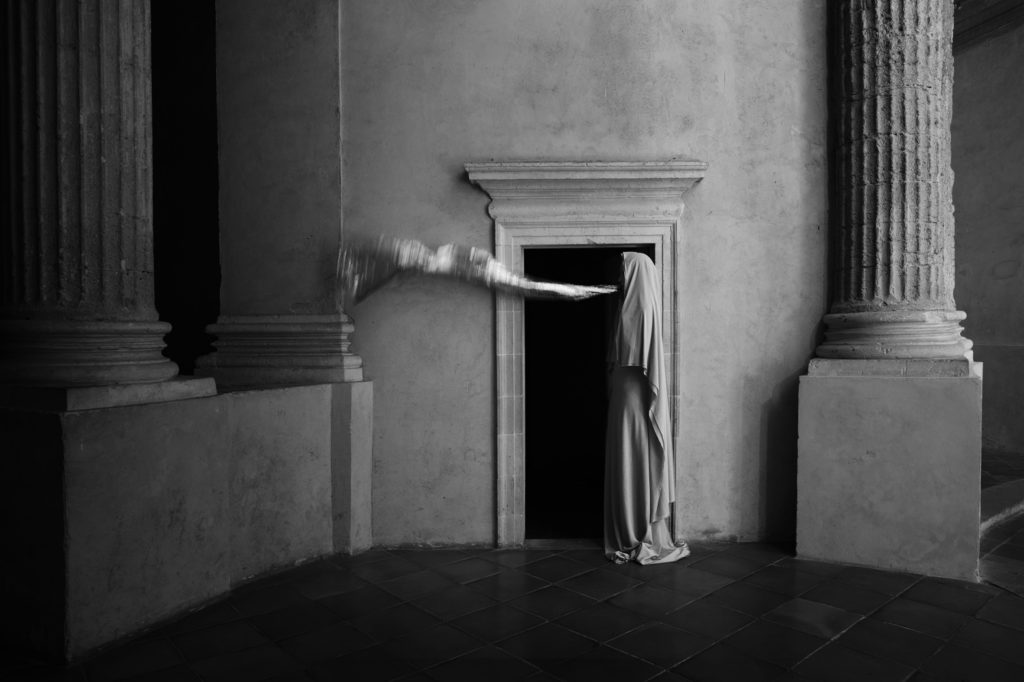
Her project: « Trance, divination, metamorphosis, passion : female characters inspired by mythology and Greek antiquity ».
«I became interested in the capacity of myths to evolve perpetually, like in literature and art history. I participate in this mobility by developing a personal and contemporary interpretation of these female incarnations of prodigies, whether they are muse, princess, goddess, nymph or human woman. I have placed them in a poetic space where everyone can recognize universal themes. This gives rise to metaphorical representations in vernacular or aristocratic, military or industrial architectures, in Languedoc and Provence. Ariane, Médée, Pénélope, Eurydice, La Pythie, Harmonie and Pandora re-enact passion, fate, divination, compassion and the search for oneself in these settings. »
Nicolas Comment, Laurie Dall’Ava and Victor Mazière, Alex Majoli
Nicolas Comment
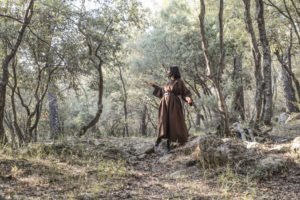 French photographer and composer born in 1973, Nicolas Comment is a graduate of the Lyon National School of Fine Arts (1997) and of the National School of Decorative Arts in Paris (1999). He published his first artist’s book in 2001 at Editions Filigranes, La desserte (The service), which were followed by 8 other books including the most recent, Reverb (Filigranes Editions / Polka gallery, 2017).
French photographer and composer born in 1973, Nicolas Comment is a graduate of the Lyon National School of Fine Arts (1997) and of the National School of Decorative Arts in Paris (1999). He published his first artist’s book in 2001 at Editions Filigranes, La desserte (The service), which were followed by 8 other books including the most recent, Reverb (Filigranes Editions / Polka gallery, 2017).
The photographic work of Nicolas Comment is represented by the Polka gallery in Paris.
During his residency and in the continuity of the works he has already devoted to Jean Cocteau L’oiseleur (The Fowler), 2003, Bernard Lamarche – Vadel La Visite (the visit), 2009, or that were inspired by writers such as Jack Kerouac and Malcom Lowry (Mexico City Waltz, 2012), Roger Vailland, Fading, 2006, Paul Bowles or William S. Burroughs, (T (ange) r), Nicolas Comment has lead a new photographic investigation devoted to the southern poet Germain Nouveau. He followed in his footsteps in Provence and the Mediterranean, from Pourrières (his native village) to Algiers (from where he wrote to Rimbaud, who had died two years before, a « ghost letter » which is still famous because it followed its recipient from port to port) through various places that have marked the life of the poet in Provence.
In addition to producing prints for a future exhibition, he intended to also exploit the visual elements gathered during his residency as part of a photographic (and musical) projection intended to be represented in various collaborating places; and work on the edition of a book-disk, published in 2020 : Nicolas Comment & Yannick Haenel, Nouveau, Mediapop éditions.
Laurie Dall’Ava
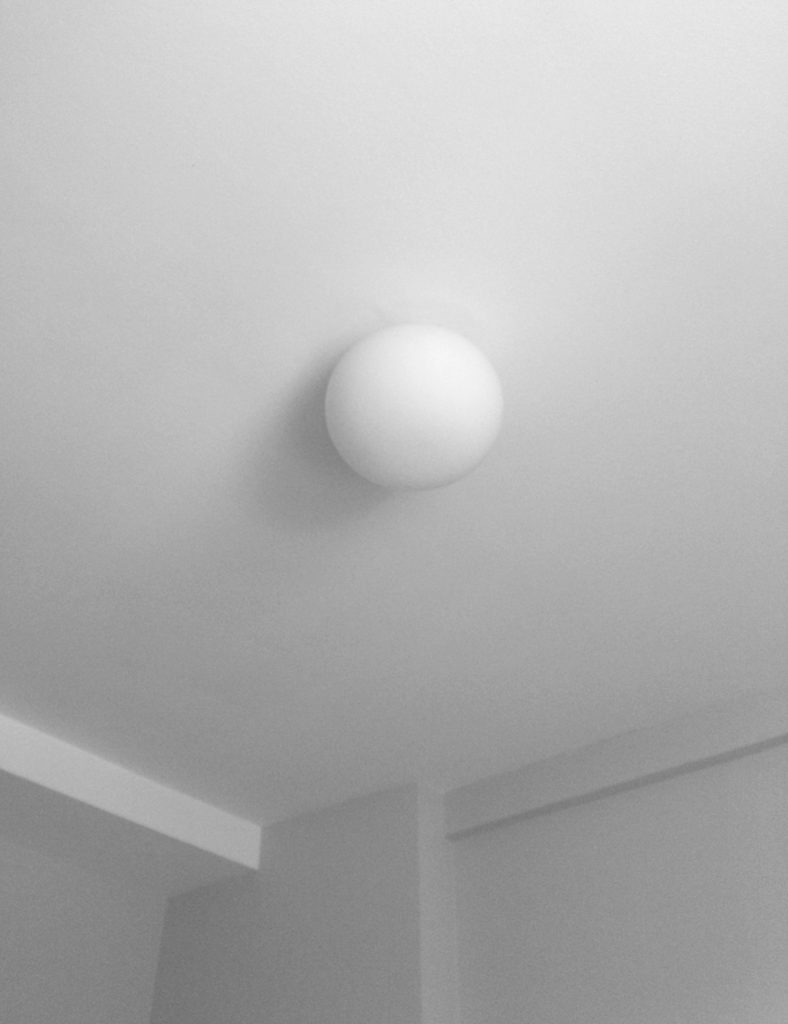
Born in 1982, Laurie Dall’Ava lives and works in France, in Toulouse. Graduated in 2011 from the Arles National School of Photography, she continued her training at the « Centro de la imagen » in Limà, Peru. In 2013, she became a member of the Reflexions Masterclass, with Giorgia Fiorio and Gabriel Bauret, in Venice / Basel.3′
In addition to numerous exhibitions since 2008, Laurie Dall’Ava has also contributed to several publications such as number 5 of the magazine Yet Magazine in 2014 or Qu’avez-vous fait de la photographie ? (What did you do with photography?) published by ENSP, Actes Sud, 2012.
The project supported by the photography prize from the Fondation des Treilles links Laurie Dall’Ava’s photographic work to Victor Mazière’s writing. This project has involved several cycles of research, as well as several forms, while privileging at each step the relationship between the territory and the invisible, the in-between and the construction of imaginary mythological clues.
“Our collaboration has led us to a photographic, poetic and philosophical research around the Mediterranean world, the Cyclades and the Minoan civilization. The narrative, both photographic and fictional, can take the form of an initiatory log and an inquiry. It would derive from a near future, of which the lacunary archive would remain, to a parallel myth of origins, guided intuitively by recurrent images, uchronic clues: stones, islands, volcano, sulfur, bees, echoing to the mystery religions and undifferentiated riddles of Linear B hieroglyphs, the best-known example of which is the Phaistos disc“.
Alex Majoli
Italian photographer born in 1971, Alex Majoli lives and works in New York where he is represented by the Howard Greenberg Gallery. Graduated from the Art Institute of Ravenna in 1991, he has been a member of Magnum Photos since 2001. He notably covered the Yugoslav conflict, the major events in Kosovo and Albania, the fall of the Taliban regime in Afghanistan, the invasion of Iraq and continues to document various conflicts for many journals.
More recently, he worked for a project of the French Ministry of Culture entitled “BPS” (Bio-Position System) on the social transformation of the city. His project Libera me is a reflection on the human condition.
Linking this human condition to his approach to conflict, his current work turns to refugees and their living conditions in exile. Alex Majoli described the project he was supposed to develop during his residency (he didn’t come to Les Treilles): « While conflicts in the world are becoming an ever-increasing threat to the lives of all those they affect, many are forced to embark on a journey that pull them away from everything they have and everything they know, across the Mediterranean and hostile countries. The refugee’s journey is reflected in the famous words of Jacques Attali: “The Titanic is us, our triumphant society, proud, blind, hypocritical, pitiless to the poor, where all is foreseen, except the means of foreseeing. This, in my opinion, is the secret of the huge success of this film: everyone guesses that the iceberg is there, waiting for us, lurking somewhere in the fog of the future, that we go straight on and that we are going we smash into music. My current project « Titanic » is an exploration of the human spirit in times of crisis. A crisis that affects everyone … »
Andrea & Magda, Pablo Guidali et Klavdij Sluban
Andrea & Magda
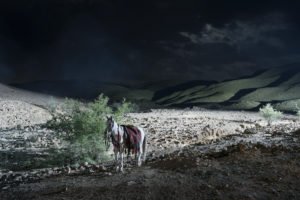
Andrea and Magda are a duo of young Franco-Italian photographers. They live and work in the Middle East since 2008. Their work is published in the press in France and abroad and gives rise to exhibitions. They regularly collaborate with NGOs and international institutions such as the Red Cross International Committee and the French Development Agency. They have already won, among other prizes, the Tabo Prize, the Fotoleggendo Festival 2015 and the Foiano Festival Prize 2013.
TV soap operas in the Middle East draw their scripts in contexts and real stories, to build an imaginary that infiltrates popular culture: series, whether produced in Lebanon, Syria, or Egypt, are viewed in all the Arab world, and constitute an important part of the “pan-Arab” culture.
Through the prism of the “Musalsalat” (soap opera in English or telenovelas in Spanish), the idea is to restore a vision of the popular imagination in the Middle East, and to question the role of television fiction in the construction of cultural models. This project is a step in a broader search on the transformations of society and territories in the Middle East, in the context of globalization, project initiated with two first chapters realized since 2012 Palestinian Dream and Sinai Park. Palestinian Dream has been exhibited in the context of the 2014 Month of Photography, and Sinai Park at the European House of Photography as part of the first biennial of photographers of the Arab world. The challenge is also to reinvent the representation of the contemporary Middle East.
Pablo Guidali
Pablo Guidali is an Uruguayan photographer and has lived in Marseille since 2011. Graduated in 2010 from the National School of Photography in Arles he was a speaker in the same school from 2011 to 2015. He also joined the Casa Velazquez from 2013 to 2014 and won many prizes including the Georges Wildenstein Prize in 2014 and the publication aid grant of the Bouches du Rhône General Council in 2015.
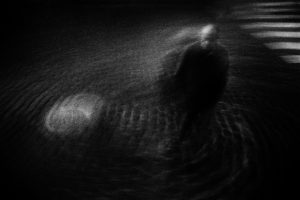 Pablo Guidali presented his project in the following way : « it involves the realization of a photographic work involving the creation of a fictional personal universe, inspired by the concept of “arrabal” and its significance in the culture of the “Rio de la Plata” – geographical and cultural area shared between Uruguay and Argentina.»
Pablo Guidali presented his project in the following way : « it involves the realization of a photographic work involving the creation of a fictional personal universe, inspired by the concept of “arrabal” and its significance in the culture of the “Rio de la Plata” – geographical and cultural area shared between Uruguay and Argentina.»
The Spanish term “arrabal” refers to a suburban group, usually associated with the lower classes, a neighborhood outside the city walls to which it belongs. In the Río de la Plata region, the use of this word refers to the territory of melting pot between immigrants – Spanish and Italian for the most part – and the populations coming from the countryside which populated the neighborhoods of the big cities towards the end of the XIXth century. These spaces later became the recurring theater of much of Rioplatense literature, one of the great inspirational subjects of tango poetry and a fundamental element of the Uruguayan and Argentinean cultural imaginary.
” During the last years, I lived most of the time in Marseille. I am attached to this city, to the life that overflows there, a palpable, confusing human life, where you can feel a mix of tragic and sad things, like in a real party. In my attraction for this city there is also a feeling of nostalgia, because Marseille inevitably evokes my attachment to other cities like Montevideo or Buenos Aires, port and cosmopolitan cities, lands of immigrants. Places in which I grew up, places that marked me, and which are at the origin of this symbolic space around which I want to build my project. »
Klavdij Sluban
 Klavdij Sluban was born in Paris in 1963. He often works with literary references, on the fringes of the immediate news. Its photographic cycles range from the East (Balkans-Transit, Around the Black Sea-winter trips, Other shores-the Baltic Sea, Trans-Siberian, etc.) to the archipelago of the Kerguelen Islands.
Klavdij Sluban was born in Paris in 1963. He often works with literary references, on the fringes of the immediate news. Its photographic cycles range from the East (Balkans-Transit, Around the Black Sea-winter trips, Other shores-the Baltic Sea, Trans-Siberian, etc.) to the archipelago of the Kerguelen Islands.
Winner of the Villa Medicis-Hors-les-Murs (1998), the Niepce Prize (2000), the European Publishers Award for Photography (2009), the Villa Kujoyama (2016), Klavdij Sluban photographed adolescents in prison since 1995 in France, ex-Yugoslavia, the former Soviet Union, Latin America, sharing his passion with young prisoners by creating photographic workshops. His works are preserved and exhibited in many institutions: Helsinki Museum of Photography, Shanghai Museum of Fine Arts, Tokyo Metropolitan Museum of Photography, Texas Tech Museum in the United States, National Museum of Singapore, Rencontres d’Arles, European House of Photography, Georges Pompidou Center. In 2013, the Niépce Museum devoted a retrospective, After Darkness, 1992-2012.
He has published many books including Entre Parenthèses, Photo Poche, (Actes Sud), Transverses (European House of Photography), Balkans Transit (Seuil), East to East (EPAP Award 2009).
Composed around exile here is how Klavdij Sluban describes his project. « What can push a twenty year-old couple to leave their native house, their native country? I never knew it. My parents never told me. In 1961, they crossed the border between Yugoslavia and Italy and walked to Paris. Fragments. Place names. Many place names, my mother had studied literature, hence the desire to go to Paris. The exile was done step by step, overnight. With stops. The course ? Difficult to trace point by point on the map. Zigzags, detours, hiding places, safe places, others not. And then stumbling again and again against the French border. A real journey that becomes imaginary in the mind of one who would like to link geographic places on a map and feelings of two young people, sometimes enthusiastic, sometimes lost, sometimes completely lost. This project, the most intimate of my photographic projects, is grounded in contemporary history, refugees, exiles bumping against the borders. This project will be treated in such a way as to leave room for the imagination. The perception of new places will be more important than the illustrative description. The feeling of the exile will be the weave of a personal photographic writing. Dazzling light, underlying, agonizing, tactile, alive, fleeting, like exile. This is a tribute to two anonymous clandestines, my parents.»
Thibaut Cuisset, Wiktoria Wojciechowska, Sophie Zénon
Thibaut Cuisset (1958 – 2017)
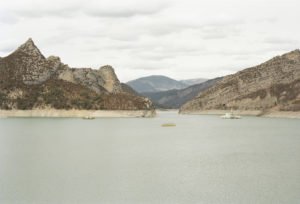 Thibaut Cuisset was a French photographer who devoted himself mainly to landscape photography. He was a resident at the Villa Medicis in 1992-1993, and a resident at the Kujoyama villa in Kyoto in 1997. He was awarded the Academy of Fine Arts in 2009.
Thibaut Cuisset was a French photographer who devoted himself mainly to landscape photography. He was a resident at the Villa Medicis in 1992-1993, and a resident at the Kujoyama villa in Kyoto in 1997. He was awarded the Academy of Fine Arts in 2009.
It was during a trip to Morocco in 1985 that he took his first landscape photographs with a photographic chamber on foot and in color. He understood then that the practice of landscape photography can be a way of looking at the world. Since then, his photographic work was deployed by successive campaigns and each time a country or a French region was the subject of the series.
Many countries were covered: Australia, Switzerland, Italy, Spain, Japan, Iceland, Namibia, Russia, Syria, the United States …
As the laureate of the Fondation des Treilles Photography Prize, he proposed, in his own words, to concentrate: «… on the French Mediterranean landscape and, more precisely, on the idea of the hinterland with the persistence of a rural and perhaps even pastoral world in Provence, in the departments of Var, Alpes-Maritimes and Alpes-de-Haute-Provence.» The forest, the mountain, and the peri-urban countryside with their zones of friction were evoked.
Among his publications: Le Pays Clair, Camargue, text written by Jean Echenoz, Ed Actes-Sud 2013, Une campagne photographique, le pays de Bray (A photographic campaign, the Bray region), text written by Gilles A. Tiberghien, Ed Filigranes in 2009, Le dehors absolu (The absolute outside), text written by Philippe Lacoue-Labarthe, Ed. Filigranes in 2006 and Campagne japonaise (Japanese Campaign), text written by Jean-Christophe Bailly, Ed. Filigranes in 2002.
Thibaut Cuisset is represented by the Les Filles du Calvaire gallery in Paris.
Wiktoria Wojciechowska
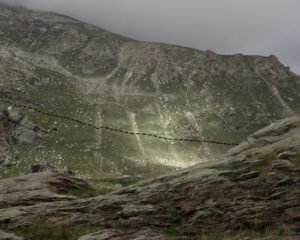 Wiktoria Wojciechowska is a very young Polish photographer, who has graduated from the Academy of Fine Arts in Warsaw, but who has already won the prestigious Oskar Barnack Newcomer Award 2015, for her series Short Flashes, composed of portraits of Chinese motorcyclists frozen in a flash.
Wiktoria Wojciechowska is a very young Polish photographer, who has graduated from the Academy of Fine Arts in Warsaw, but who has already won the prestigious Oskar Barnack Newcomer Award 2015, for her series Short Flashes, composed of portraits of Chinese motorcyclists frozen in a flash.
With her Sparks series of portraits of Ukrainian soldiers, she tried to show the traces of war on the faces and eyes of young fighters.
Her project, the Path, on which she worked as part of her residency at the Fondation des Treilles, is a mixture of portraits, collages and investigations on the Mediterranean territory, a story telling in search of a representation graphic following human destinies from prehistoric times to the present day.
hat she proposed as part of her Residence for photography in les Treilles was a mixture of portraits, pastings and investigations on the territory, a story telling in search of a graphic representation of what characterizes Mediterranean culture.
Her publications include : Urbanautica, text by Krzysztof Sienkiewicz to Project Own Place 2015. Short Flashes, Beijinger, No. 06, China, 2015
Sophie Zénon
Sophie Zénon is a French photographer. She lives and works in Paris. Trained in contemporary history, art and ethnology, she first deployed her work in contact with new cultures and traveled to Asia many times. Since the late 2000s, echoing her studies on shamanism, she returned to her favorite research themes: the photographic staging of absence, our relationship to time, memory, filiation. Winner of the Kodak Prize for Criticism in 2000, nominated for the Niépce Prize in 2011 and 2015, at Villa Kujoyama in 2015, she has been the subject of numerous exhibitions in France and abroad, and her photographs and artist’s books have integrated public collections.
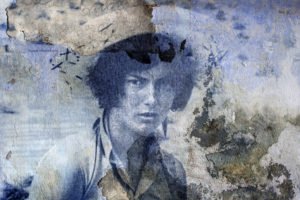 The Residence for Photography Prize from the Fondation des Treilles allowed her to develop a part of her project «Arborescences» (trees), a work of re-visitation of her family history intimately linked to that of Italian immigration in France between the two great wars. This project has its source in a buried memory and deals with exile, identity, the loss of the places where we were born, where we lived.
The Residence for Photography Prize from the Fondation des Treilles allowed her to develop a part of her project «Arborescences» (trees), a work of re-visitation of her family history intimately linked to that of Italian immigration in France between the two great wars. This project has its source in a buried memory and deals with exile, identity, the loss of the places where we were born, where we lived.
What does it mean today, in this global context of migration, to see yourself from somewhere? What story, what imagination can you transmit when you lack everything? In the heart of the rice fields of Italian Piedmont, she revisits, in the shade of her maternal grandmother, the figure of the mondina, which has inspired many artists, filmmakers and musicians.
She has put on numerous exhibitions and publications and received numerous awards: winner of the Kodak Prize for Critics in 2000, nominated for the Niépce Prize in 2011 and 2015, for the Villa Kujoyama in 2015. Her photographs and artist’s books have incorporated public collections.
Her exhibition catalogue, Dans le miroir des rizières (in the mirror of the rice fields), was published in octobre 2017 by the Thessa Herold gallery.
Anaïs Boudot, Hicham Gardaf, Evangelia Kranioti
Anaïs Boudot
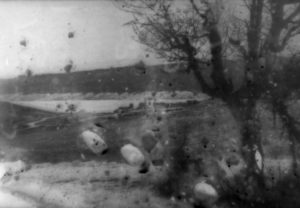 She is a French photographer living in Roubaix. Graduated from the National School of Photography in 2010 and of the Fresnoy studio in 2013, Anaïs Boudot continues today a work around the exploration of photographic means. The heart of her work is to explore the process of appearance of the image; the links between still and animated images; and the interstices created between time and movement. She seeks to create both enigmatic and hypnotic images, out of time, closer to the sensation. Her artworks often play with the limits of the visible, plunging the viewer into a subjective temporality close to remembrance. The question of landscape and perception is important. Her work is based on a hybridization of mediums through the updating of old photographic techniques such as stereoscopy, photogram or pinhole, which, combined with the use of programming and video, develop new forms and new visions. Author of numerous exhibitions and publications, she was a member of the Casa de Velázquez in 2016-2017.
She is a French photographer living in Roubaix. Graduated from the National School of Photography in 2010 and of the Fresnoy studio in 2013, Anaïs Boudot continues today a work around the exploration of photographic means. The heart of her work is to explore the process of appearance of the image; the links between still and animated images; and the interstices created between time and movement. She seeks to create both enigmatic and hypnotic images, out of time, closer to the sensation. Her artworks often play with the limits of the visible, plunging the viewer into a subjective temporality close to remembrance. The question of landscape and perception is important. Her work is based on a hybridization of mediums through the updating of old photographic techniques such as stereoscopy, photogram or pinhole, which, combined with the use of programming and video, develop new forms and new visions. Author of numerous exhibitions and publications, she was a member of the Casa de Velázquez in 2016-2017.
Hicham Gardaf
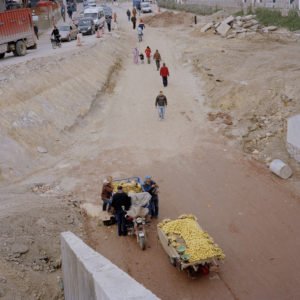 He is a Moroccan photographer born in Tangier, where he lives. He works on the representation of the major changes that the Arab world undergoes. Inspired by numerous photography books, that he came across during his job as a bookseller, he set his first steps in photography by taking images in his neighbourhood in order to portray his surroundings and the people living there ; following the explorations of the documentary genre such as Stephen Shore or Joel Steinfeld.
He is a Moroccan photographer born in Tangier, where he lives. He works on the representation of the major changes that the Arab world undergoes. Inspired by numerous photography books, that he came across during his job as a bookseller, he set his first steps in photography by taking images in his neighbourhood in order to portray his surroundings and the people living there ; following the explorations of the documentary genre such as Stephen Shore or Joel Steinfeld.
He has been nominated for the Foam Paul Huf Award in February 2013. The same year he participated in a group show of ten contemporary Moroccan photographers at the Museum of Marrakech for Photography and Visual Arts (where his work became a part of the museum’s permanent collection); followed by a solo exhibition titled Extimacy in the Gallery 127 in Marrakech.
His work was represented in the Fotofever in Paris and Brussels. He was included in the group exhibition Un Maroc Raconté Autrement (A different story of Morocco) at the Hotel de Sauroy in Paris (part of the Paris Photomonth) with the project titled Modern Times, in which he portrays the contemporary Moroccan society against the background of urban landscape and its recent development.
He observes the relationships between man and his environment, more specifically how each individual fits or not to the space or territory in which he lives. His project for les Treilles was a description of the major urban and socio-cultural transformations, the question of identity and the vision of the modern society of the Arab world on the West.
Hicham Gardaf is represented by the Gallery 127 in Marrakech.
Evangelia Kranioti
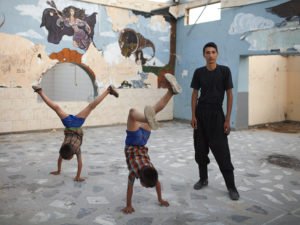 She is a visual artist born in Athens and living in Paris. Evangelia Kranioti has conducted an artistic and anthropological research on the life, travels and intimacy of Mediterranean sailors around the world. A new stage in this research leads her to focus not more on people in the sea stricto sensu, but on Mediterranean migrants, men and women who embark at the risk of their lives to reach Europe.
She is a visual artist born in Athens and living in Paris. Evangelia Kranioti has conducted an artistic and anthropological research on the life, travels and intimacy of Mediterranean sailors around the world. A new stage in this research leads her to focus not more on people in the sea stricto sensu, but on Mediterranean migrants, men and women who embark at the risk of their lives to reach Europe.
She graduated in law and visual arts at the National School of Decorative Arts in Paris and at Le Fresnoy – National Studio of Contemporary Arts. She also attended the Atelier Scénario de la Fémis.
Winner of numerous grants and prizes, her work encompasses photography, video, installation and is regularly exhibited in France and abroad: Paris Photo, Biennial of moving images, Geneva Contemporary Art Center, Palazzo Grassi, Faena art, European House of Photography, Tokyo Place, NY Photo Festival, Thessaloniki Biennale, MAC Créteil, FotoRio, CentQuatre, Nuit Blanche Bruxelles, ACFNY, etc.).
Her first documentary Exotica, Erotica, Etc. had its premiere at the 65th Berlinale Forum. Her second film Obscuro Barroco had its premiere at the Panorama of the 68th Berlinale where he was awarded the Teddy Jury Award. Subsequently, the two films were shown at festivals, museums, film libraries and art centers around the world.
Claire Chevrier, Patrizia Di Fiore, Marc Lyon
CLAIRE CHEVRIER
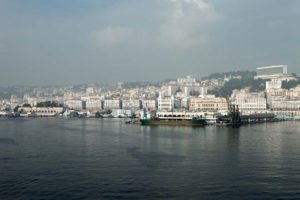 Born in Pau in 1963, she lives and works between Mayet and Paris. She graduated from the Art School of Grenoble. Since the mid-1990s, she has participated in collective and personal exhibitions in France and abroad. Claire Chevrier is one of the twenty photographers selected for the 6th edition of the Photography and Architecture Triennale. She has published many books and her works appear in collections of the European House of Photography, the Regional Fund for Contemporary Art (Pays de la Loire and Rhône Alpes) and the Nicéphore Niépce Museum.
Born in Pau in 1963, she lives and works between Mayet and Paris. She graduated from the Art School of Grenoble. Since the mid-1990s, she has participated in collective and personal exhibitions in France and abroad. Claire Chevrier is one of the twenty photographers selected for the 6th edition of the Photography and Architecture Triennale. She has published many books and her works appear in collections of the European House of Photography, the Regional Fund for Contemporary Art (Pays de la Loire and Rhône Alpes) and the Nicéphore Niépce Museum.
Her photographs are part of public collections, including that of the European House of Photography, the National Fund of Contemporary Art … For several years, she has been working recurring themes related to man, space, power, memory.
In her previous work, Claire Chevrier observed how megacities have gradually absorbed the natural space to transform it into as many neighborhoods and population groups marked by the evolution of the primitive city, but also by the unpredictable changes of the weather, economy and culture. Coming from a family of “pied-noirs” (French National born in North African colonies) and deeply marked by the story of this grief experienced by her family, she photographed and questioned Algiers the White in her urban, social and cultural metamorphoses, in search of landscapes of memory. She analyzed, in this so prolific period caused by recent political evolutions, how man appropriates this new territory in his body and his thought.
PATRIZIA DI FIORE
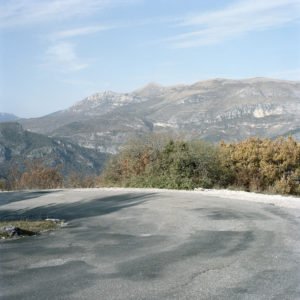 Born in 1961 in Italy, she lives and works in Paris. In 2014, her work is exhibited at the 15th Photographic Art Exhibition in Beijing. Previously her photographs were exhibited at the European House of Photography, at the Photographic Meetings in Solignac, at the Biennale of Photography Canton in China, at the Aquitaine Museum in Bordeaux … She has benefited from scholarships including that of aid to the Creation of the Ministry of Culture, France, Luxembourg or the Bourse Lavoisier. For the past 30 years, her work has revolved around the landscape and its relationships with history and man. Her images emphasize the ties that bind the individual to their land, to their history. She works, in particular, on lands of conflict: Bosnia, Palestine, Vietnam, Poland …
Born in 1961 in Italy, she lives and works in Paris. In 2014, her work is exhibited at the 15th Photographic Art Exhibition in Beijing. Previously her photographs were exhibited at the European House of Photography, at the Photographic Meetings in Solignac, at the Biennale of Photography Canton in China, at the Aquitaine Museum in Bordeaux … She has benefited from scholarships including that of aid to the Creation of the Ministry of Culture, France, Luxembourg or the Bourse Lavoisier. For the past 30 years, her work has revolved around the landscape and its relationships with history and man. Her images emphasize the ties that bind the individual to their land, to their history. She works, in particular, on lands of conflict: Bosnia, Palestine, Vietnam, Poland …
Patrizia di Fiore readily admits, the influence of light, colours and Italian landscapes have marked her practice of photography. Since she arrived in France thirty years ago, this culture influenced by the flamboyance of Italian paintings, has gradually been replaced by a more analytical vision. She therefore intends to take into account, in her description of the Mediterranean landscape, the upheavals generated by major works such as the construction of the TGV, with works of art that disrupt the vision or the development of highways that drain from north to south a migrant population flows, seasonal or otherwise. She thinks she will roll out her palette of colors to evoke the history and cultures that are emerging in this territory where traces of different civilizations still exist.
MARK LYON
Born in 1952 in California, Mark Lyon lives and works in France. He is represented by galleries in New York (Robert Mann Gallery) and Paris (Air de Paris). His work is part of the museum collections of the National Library (France) and the Yale Art Gallery (USA).
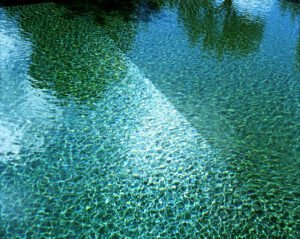 His work revolves around portraiture, architecture, and especially post-modernism: Le Corbusier’s work in India, Pierre Charreau’s Maison de Verre in Paris or Jean Prouvé’s Maison tropicale.
His work revolves around portraiture, architecture, and especially post-modernism: Le Corbusier’s work in India, Pierre Charreau’s Maison de Verre in Paris or Jean Prouvé’s Maison tropicale.
He studied photography at Yale University in the United States. In 1979, he co-directs a gallery in Paris. In 1984, he is a freelance photographer, works for publications: AD, Artforum, Harper’s Bazaar, The New Yorker, Le Monde… His work was exhibited at the Hammer Museum in Los Angeles at the Issue Project Room in New York, Millennium of Fashion in Kyoto and Tokyo, at the Eof gallery in Paris. He received scholarships from the Graham Foundation, the PDN / Nikon Award …
Born in Southern California, Mark Lyon proudly claims his share of historical and visual heritage in terms of the language, culture and Hispanic landscape conveyed by his parents. And if he admits a deep love for the Mediterranean landscapes, his photographic influences are resolutely American since he fervently quotes the work of Walker Evans on America. In this way, he wishes to adopt his mentor’s methodology, namely to transgress genres, to combine in the same photographic history a work on landscape, architecture, the human, the still life, that his observations and his wanderings are gradually revealing him.
Morgane Denzler, Manuela Marques
Morgane Denzler
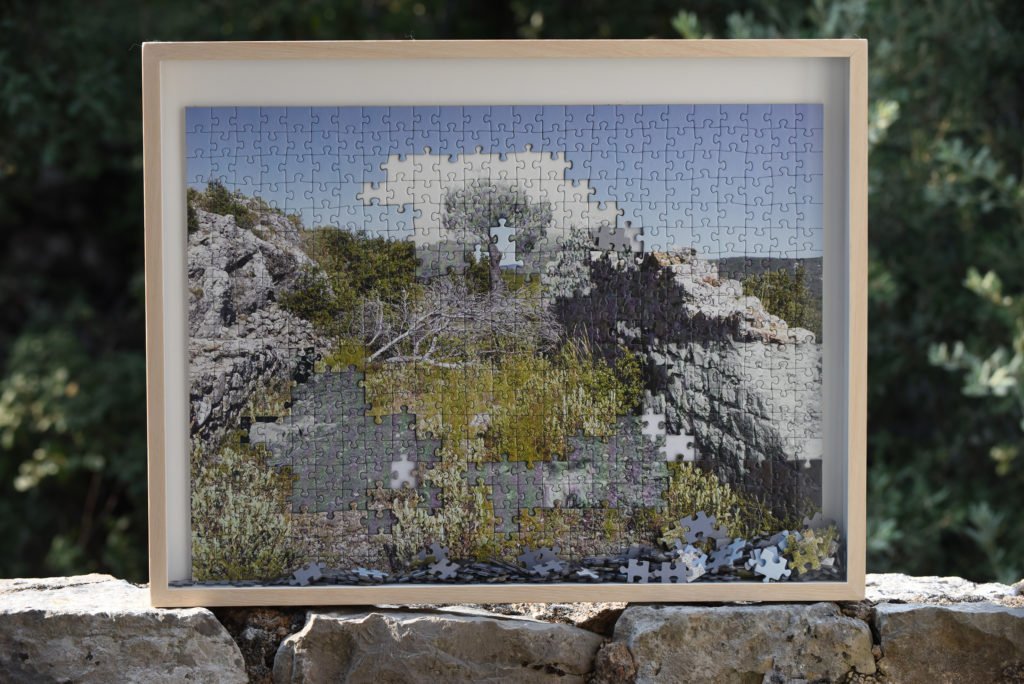 Morgane Denzler lives and works in Brussels. She followed the training course of the Paris Fine Arts School, notably in the Patrick Tosani’ studio. She is particularly interested in the Mediterranean Basin (her first works concerned Sicily and Lebanon) and wished to address the history, memory and collective unconscious of the Provençal territory through documents and meetings. After a research phase on maps, archives and photographic documents of the emblematic places of this territory, she wanted to find the exact location and then photograph them as they look today.
Morgane Denzler lives and works in Brussels. She followed the training course of the Paris Fine Arts School, notably in the Patrick Tosani’ studio. She is particularly interested in the Mediterranean Basin (her first works concerned Sicily and Lebanon) and wished to address the history, memory and collective unconscious of the Provençal territory through documents and meetings. After a research phase on maps, archives and photographic documents of the emblematic places of this territory, she wanted to find the exact location and then photograph them as they look today.
This work done, she created puzzles by superimposing, on the same scale, archival photography and contemporary shooting, taking care to remove some elements from the upper puzzle so that each layer of the work makes it possible to understand the genius of the place.
Morgane Denzler participated in Sans tambours, ni trompettes – Cent ans de guerre (without tambours, no trumpets – a hundred years of war), Parvis, Pau; à Tous, des sang-mêlés (to all, mixed bloods), MAC VAL, Vitry-sur-Seine, and to the Riga Photography Biennial, Lithuania. She has been awarded several prizes and residences.
Manuela Marques
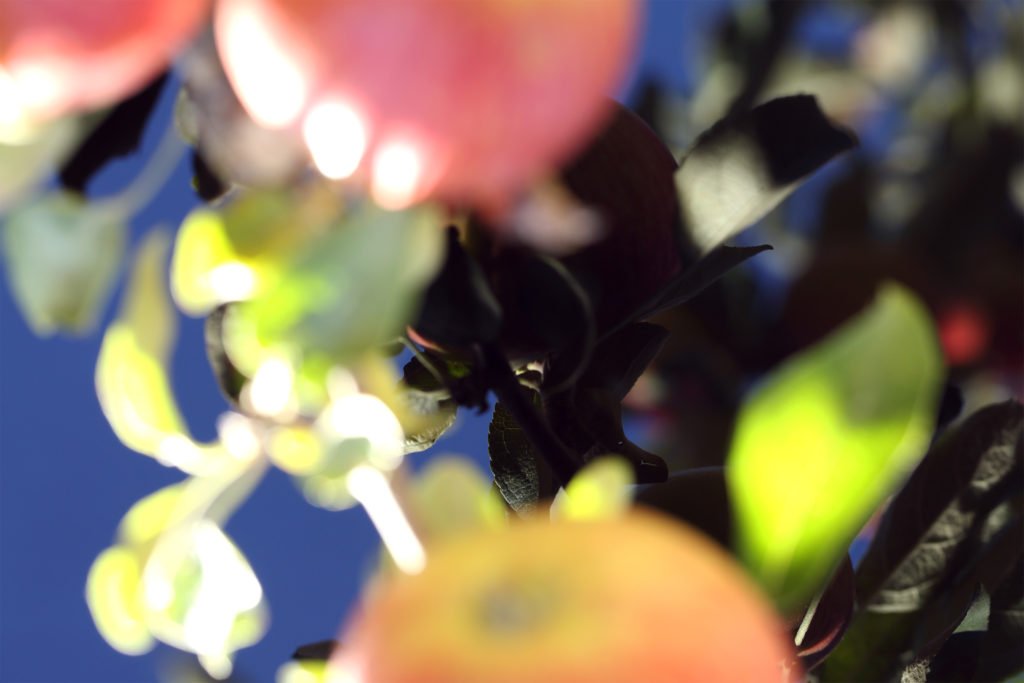 Of a French-Portuguese nationality, Manuela Marques is known for the quality of the lights and the color range that she uses. Inspired by the diary of Anne Schlumberger, creator of the Fondation des Treilles, who relates experiencing a rare and unique feeling of perfect beauty in front of the calm and harmony of this landscape, Manuela worked on visual games which combine both the blue lights of dawn and twilight to find the part of the « waking dream » that attracted her as well as the feeling of interiority spread by the very nature of this landscape, as an eternal utopia. She regularly exhibits her work in important institutions around the world. She has published several books and received many awards. Her works are included in collections such as that of the National Fund for Contemporary Art and the Gulbenkian Museum in Lisbon.
Of a French-Portuguese nationality, Manuela Marques is known for the quality of the lights and the color range that she uses. Inspired by the diary of Anne Schlumberger, creator of the Fondation des Treilles, who relates experiencing a rare and unique feeling of perfect beauty in front of the calm and harmony of this landscape, Manuela worked on visual games which combine both the blue lights of dawn and twilight to find the part of the « waking dream » that attracted her as well as the feeling of interiority spread by the very nature of this landscape, as an eternal utopia. She regularly exhibits her work in important institutions around the world. She has published several books and received many awards. Her works are included in collections such as that of the National Fund for Contemporary Art and the Gulbenkian Museum in Lisbon.
The book of her work made in les Treilles, La taille de ce vent est un triangle dans l’eau (The size of this wind is a triangle in the water), was published at the Loco Editions in may 2014.
Raed Bawayah, Véronique Ellena
Raed Bawayah
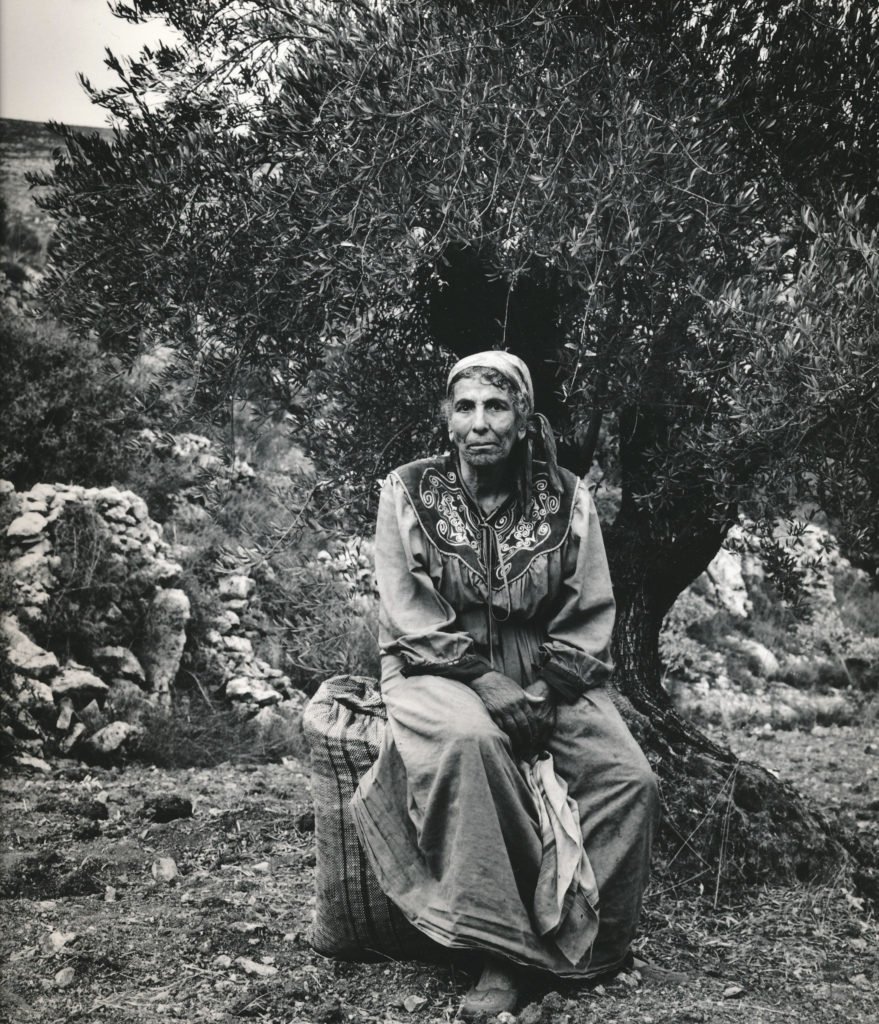
Born in Palestine and graduated in 2004 from the Musarara school of photography in Jerusalem, Raed Bawayah exhibited the following year in Paris – at the Cité Internationale des Arts, at the City Hall – as well as in Perpignan, at “Visa pour l’image”, in 2007. In 2009 his work was selected for the Discovery Prize of the Rencontres d’Arles (Arles photographic meetings). His works are presented in the collection of the European House of Photography and of the National Fund for Contemporary Art.
If Raed Bawayah relies on the image of the olive tree to start his project, it is because this tree, a symbol of peace common to all Mediterranean culture, conveys a sense of peaceful wisdom and exemplary resistance in front of the attacks of nature and that of men; the olive tree, a true metaphor for the struggle of the Palestinian people, which tries, even in despair, to cling to its nourishing land, remains the starting point for a photographic quest that explores the territorial problematic and the topographic survey of a torn earth, desired and claimed by two peoples.
Raed Bawayah’s series of photographs include: Souvenirs d’enfance (childhood memories), Bon voyage (Have a safe trip), Deadlines, Faces Shadow, Bonne Année Jénine (Happy New Year Jenine), ID925596611, Paris le jour (Paris by day), Demi-tour…droite ! (U-turn… Right !), La couleur du soleil (the color of the sun), En construction (under construction), Les veines de la Terre (the earth veins), Les serres froides (cold greenhouses), Love Pills, Les Collines Hautes (high hills), Les hommes derrière (men behind), Les Ames blanches (white souls), Le jus de l’esprit (Spirit Juice), Les Pieds Papillons (butterfly feet), Les craquelures (cracks).
Véronique Ellena
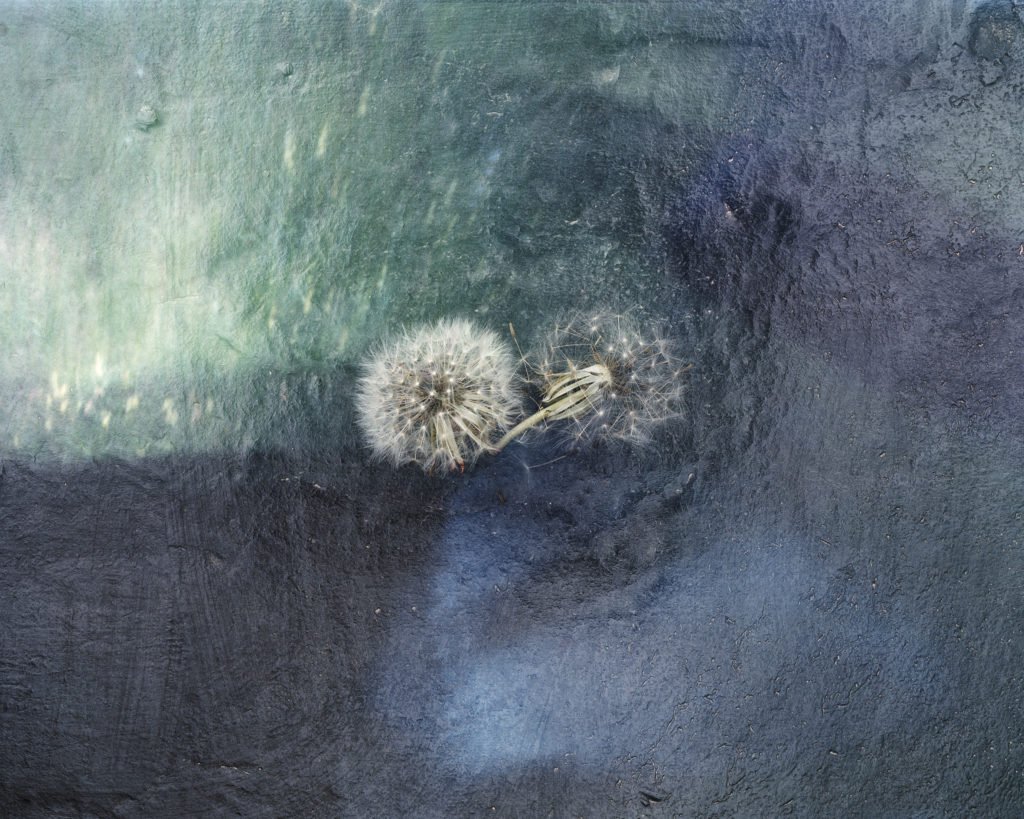 Véronique Ellena has become known for her work done at the Villa Medici on the theme of still life and her very pictorial research around the homeless, « the invisible ones ».
Véronique Ellena has become known for her work done at the Villa Medici on the theme of still life and her very pictorial research around the homeless, « the invisible ones ».
Her photographic journey is crossed by questions about the place of man in the world, spirituality and nature. For years she has been pacing up and down territories in search of simple beauty. Let us quote for example this tree in the mist imbued with romanticism, this valley forming like the back of a huge primitive animal, this wave exploding in a calm horizon.
Without claiming the aesthetics of land art, she has been accustomed for several years to survey different territories, during long and slow walks to compose meditative and silent images like this apple tree under the storm or these poplars indefinitely repeated by the reflections of the lake. Taking as a pretext the semi-wild nature of the Treilles estate, she composed a herbarium around the ancient and eternal vegetation of the place through the seasons.
She won the Bettencourt Prize in 2016 for the millennium stained glass window in Strasbourg Cathedral. Her work has been shown in the Florence and Damien Bachelot collection at the Hôtel des Arts in Toulon, as well as in the rue des Arts (Arts street) where she showed her work on daily life. Her work was the subject of a retrospective at the Musée Réattu, in Arles, in 2018 at the International Photography Meetings.

